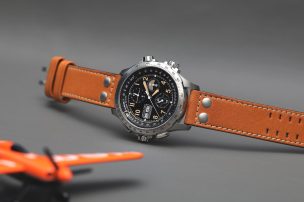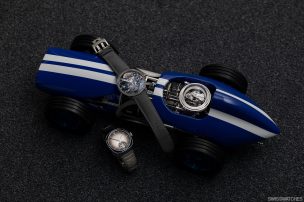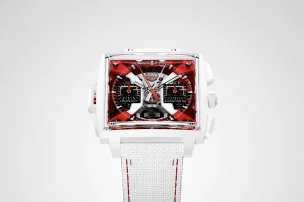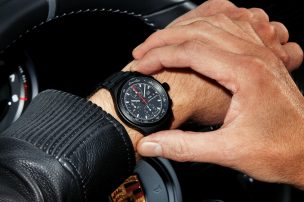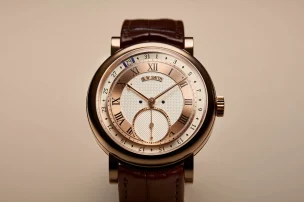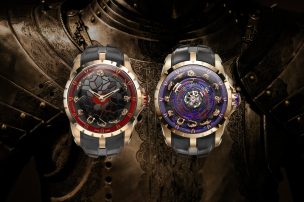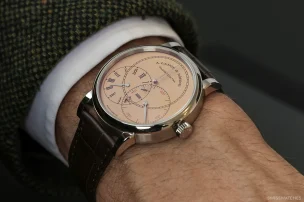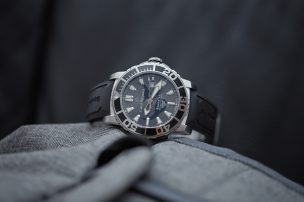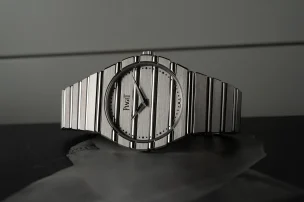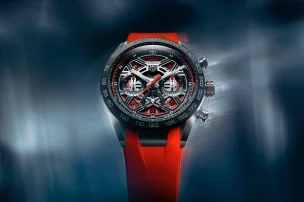
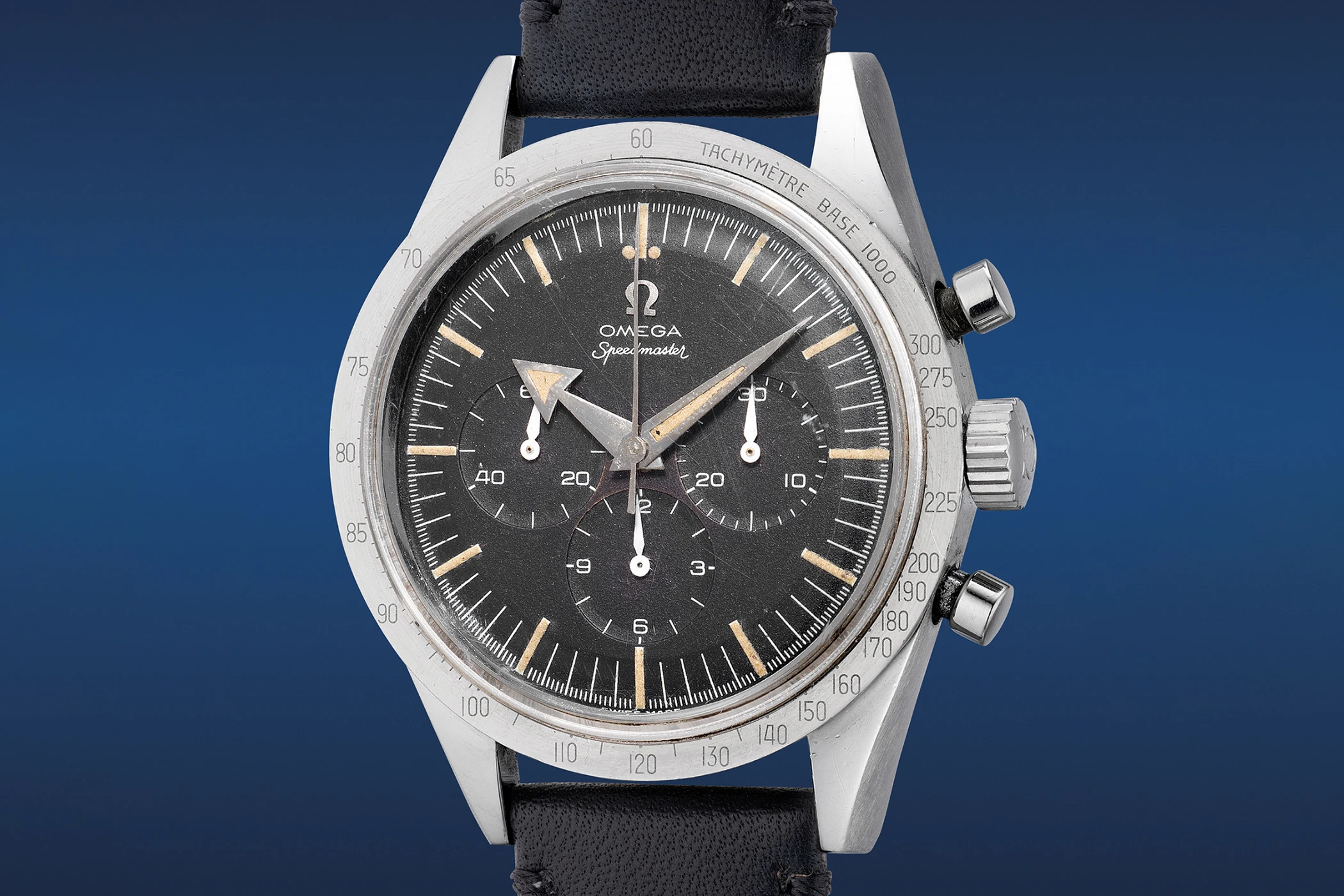
The Most Expensive Omega Wristwatches of All Time
The history of the most expensive Omega watches ever offered at auction is simultaneously a narrative of the brand’s greatest achievements, its illustrious heritage, and the most exquisite models it has produced throughout its long corporate history. The timepieces’ lofty prices are, in a sense, a reflection of the rich tradition they carry, and their justification becomes clear when collectors are willing to pay for the stories behind the watches. To precisely understand what contributes to their extraordinary value, we are going to delve into the details of the most expensive Omega watches.
10. Ref. CK2915-1
The Omega Speedmaster’s story begins with Reference 2915, which was produced between 1957 and 1959. It was crafted in three distinct versions: -1, -2, and -3, with the CK2915-1 being the inaugural model. This reference quickly became the most coveted of all Speedmaster models. Distinguished by its unique dial design and its case’s key elements, it set itself apart from all subsequent Speedmaster generations. The allure of this watch is further magnified by the cult status of the ‘Moonwatch’ and its historical connection to NASA. When astronaut Buzz Aldrin set foot on the lunar surface on 21 July 1969 during the Apollo 11 mission, he was wearing an Omega Speedmaster.
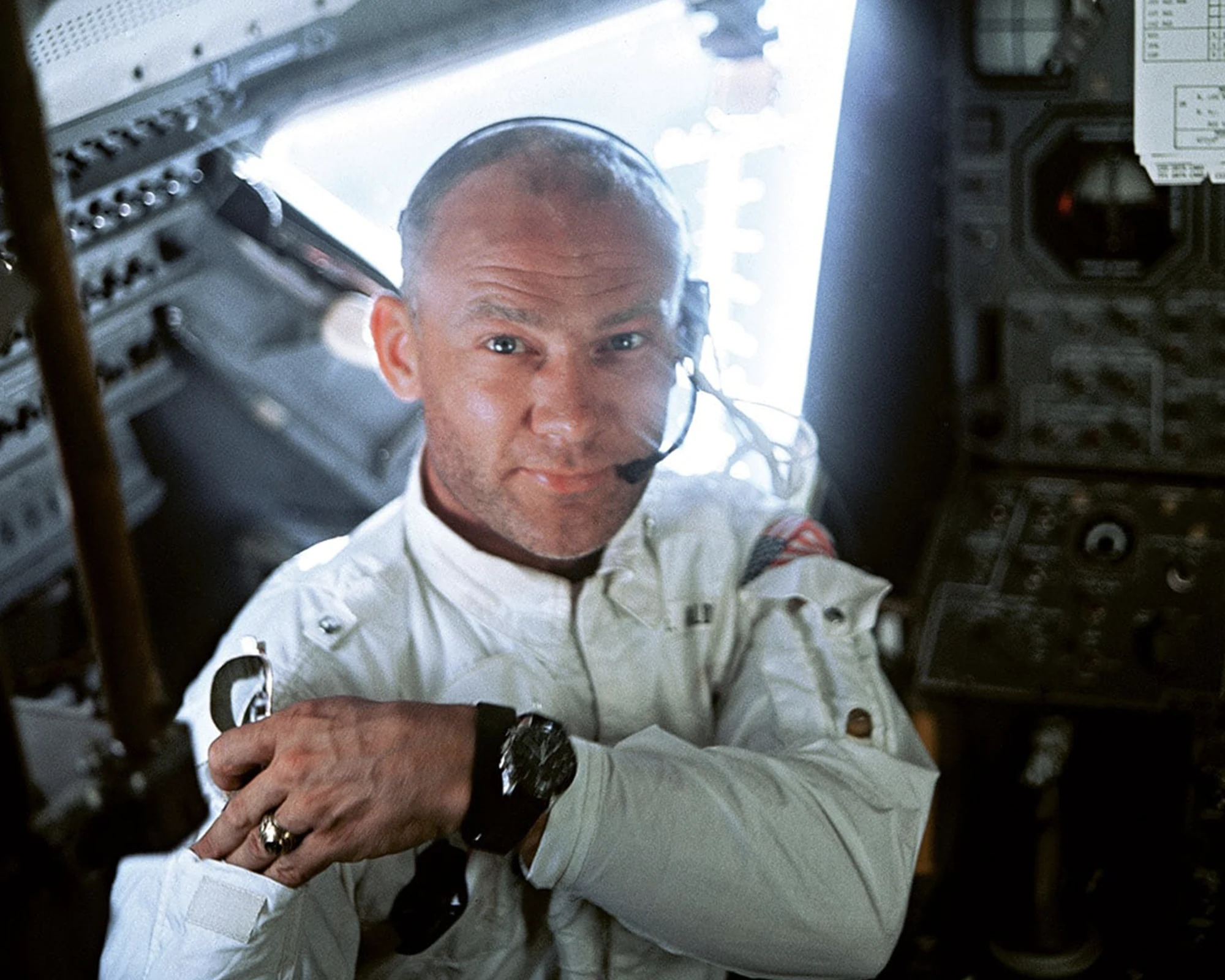
Astronaut Buzz Aldrin with his Omega Speedmaster
However, for collectors, it is not only the good condition of the watch but also its originality—meaning the authenticity of its components—that is of paramount importance. Questions such as whether the markings on the dial or hands have been repainted, which parts are not original, or whether the case has been polished and thereby lost its original contours, all dictate how much collectors are willing to invest to obtain the object of their desire.
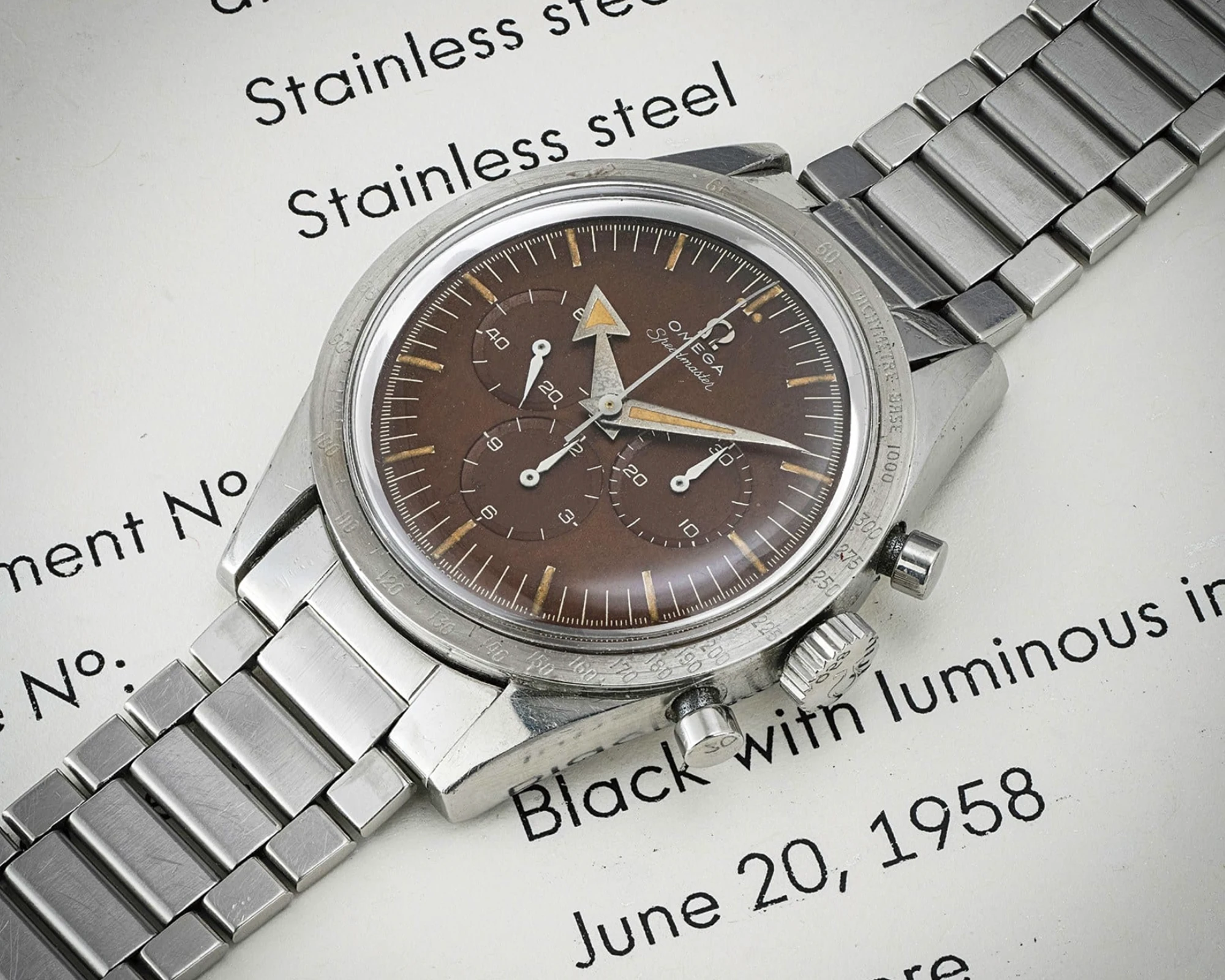
Credit © Phillips
These factors were crucial in determining the appeal of the Ref. CK2915-1, which was auctioned by Phillips in 2022. As the first and thus most sought-after Speedmaster reference, it was equipped with original parts and the collectors’ so highly-prized details, making it a ‘grail’ watch in multiple respects. The first of these reasons is the rare Base 1000 metal bezel with the flat ‘3’, followed by the large ‘Broad Arrow’ minute and hour hands, and the metal bezel—rather than a bezel with a black insert. The Omega logo features the oval ‘O’, which would later become fully round, and the case back bears a clear ’Speedmaster’ engraving along its edge. It was also the first chronograph to feature a tachymeter scale (or, as Omega referred to it at the time, the ‘Tachy-Productometer’ scale) on the bezel rather than on the dial.
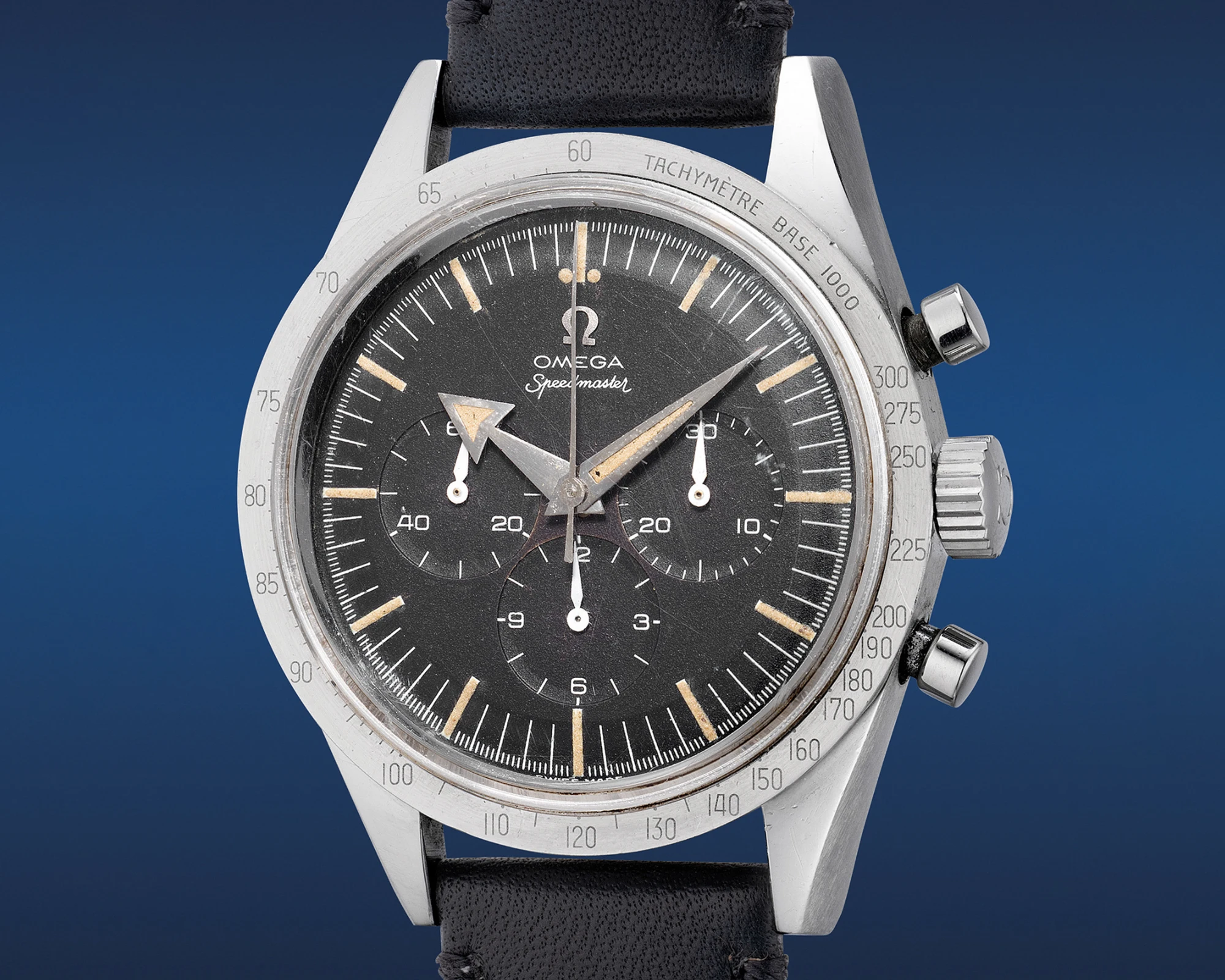
The Omega Speedmaster Ref. CK2915-1 from 1958
Credit © Phillips
All these attributes culminated in the Ref. CK2915-1 going under the hammer for approx. 260,034 CHF (2,394,000 HKD).
9. Ref. 145.012-68SP
The connection between Omega and aviation, which is associated unlike any other with Omega watches, extends deep into the brand’s history. After NASA consulted with Rolex, Longines-Wittnauer, Hamilton, and Omega as requested by astronauts who wanted to wear a timepiece on their wrists during training and flights, the space agency began testing wristwatches for the space programme in 1964. It was in 1965 that a NASA-qualified Omega Speedmaster (Ref. 105.003) went on its first journey into space on an astronaut’s wrist, having outperformed its competitors in a series of rigorous tests, including high-temperature, humidity, and acceleration assessments.
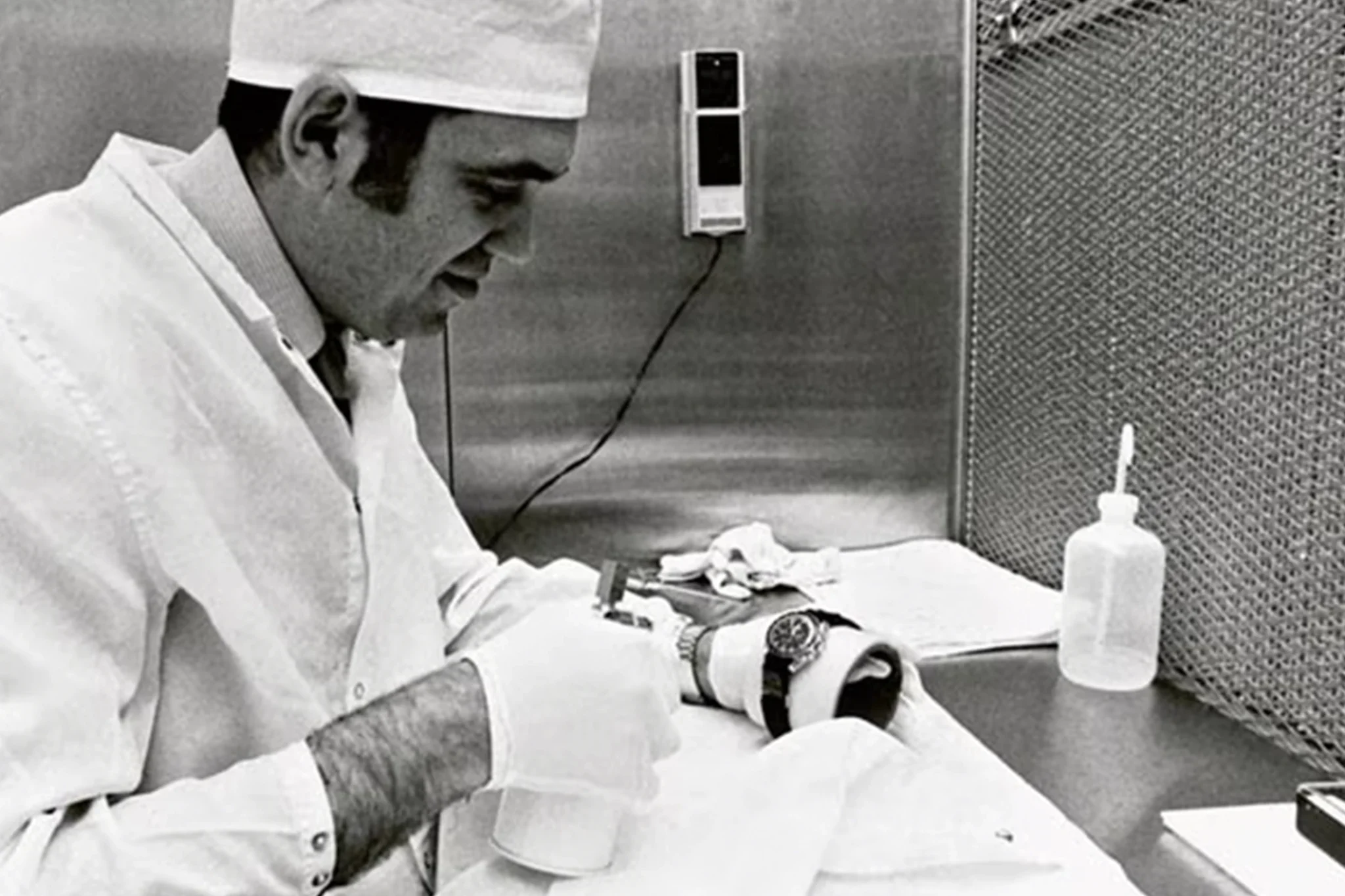
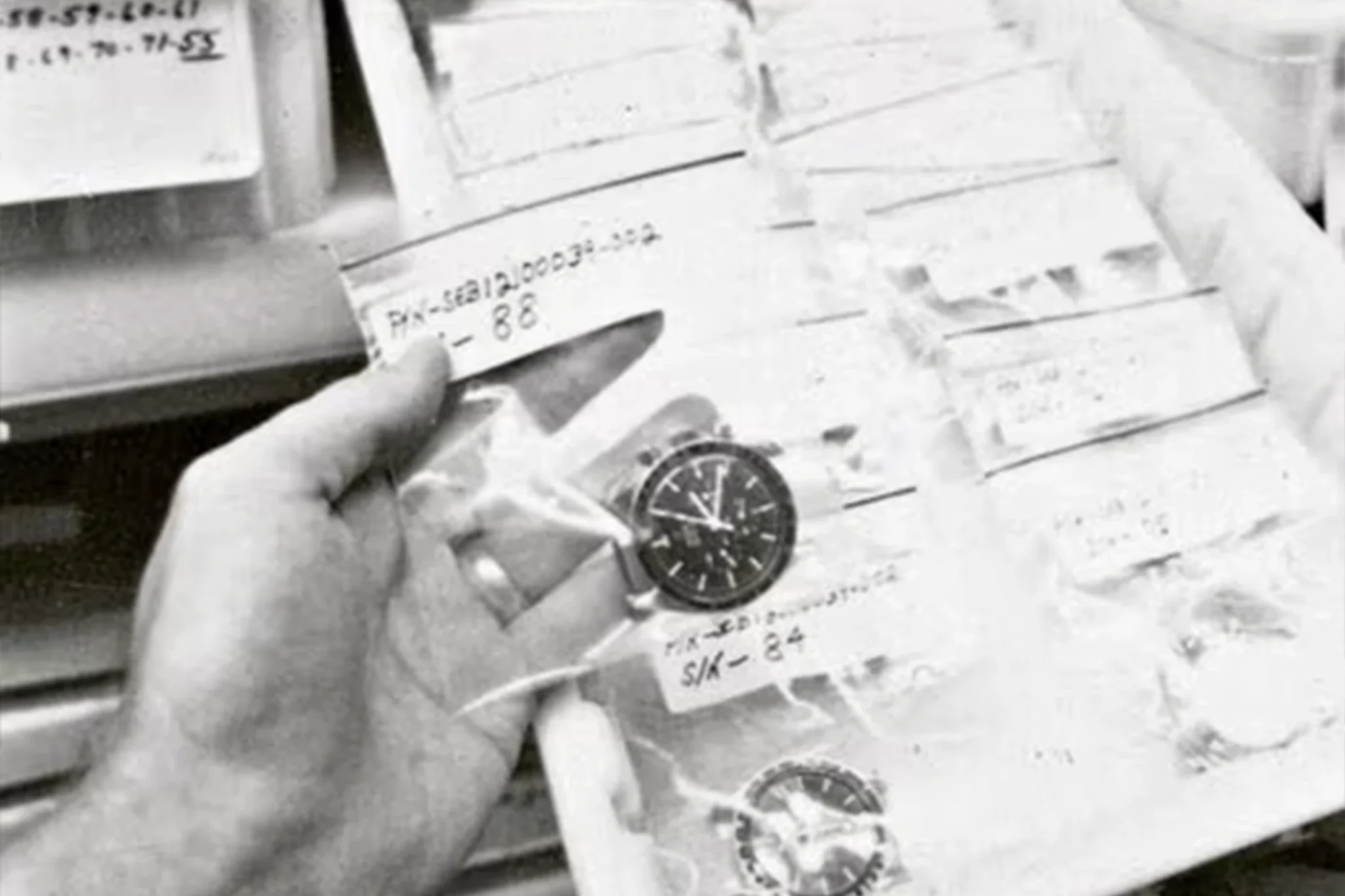
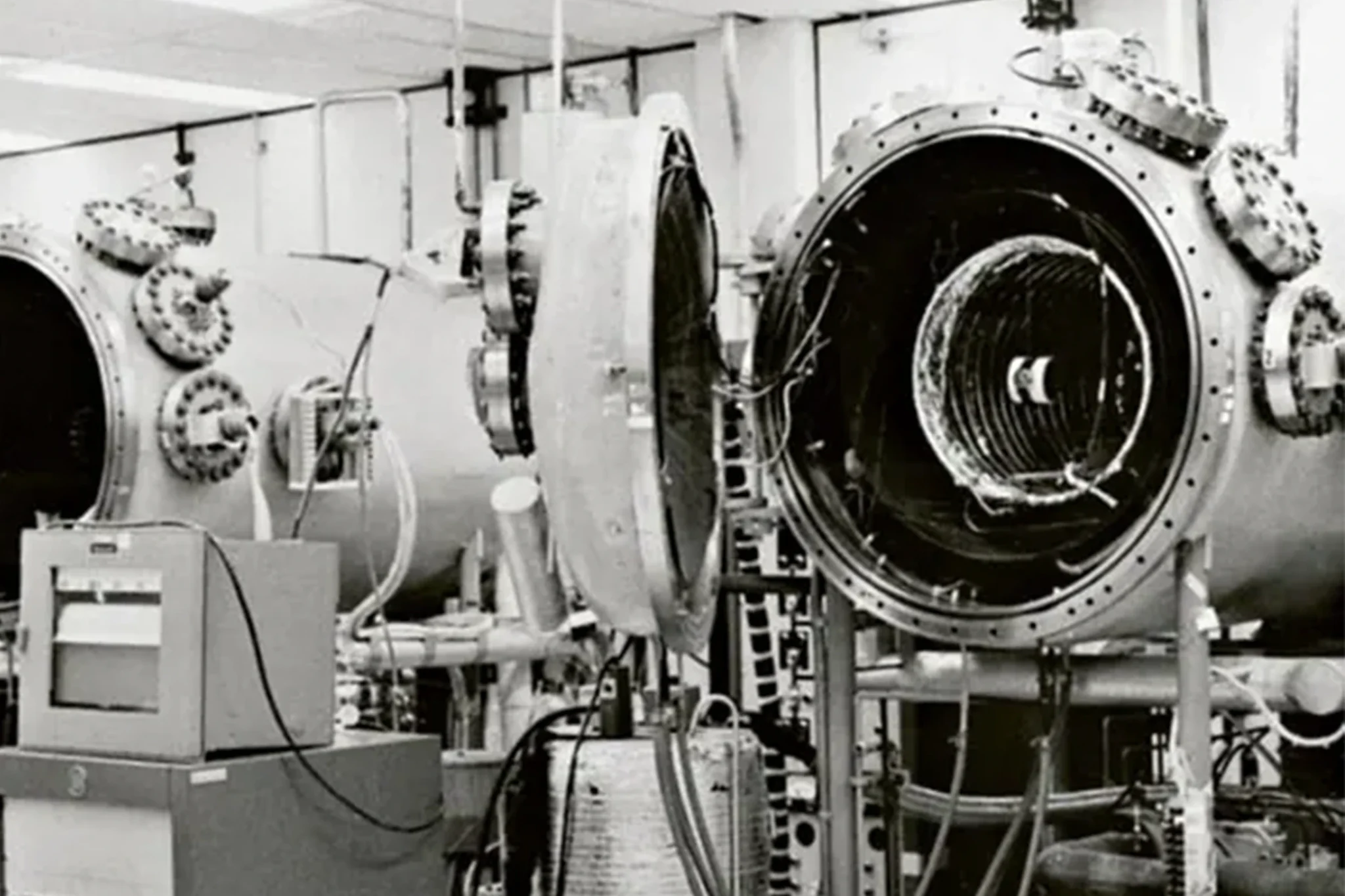
From that point onward, Omega supplied NASA with Speedmaster Professional watches. Thus, the entire Apollo 11 crew—Neil Armstrong, Buzz Aldrin, and Michael Collins—wore the fourth-generation Speedmaster. Armstrong and Aldrin were equipped with the Speedmaster Professional (Ref. 105.012, -65 for Armstrong), while Collins wore a Speedmaster Professional (Ref. 145.012-68).

Interestingly, however, the first Speedmaster was in space nearly two and a half years before NASA officially declared it suitable for all manned space missions. It was astronaut Wally Schirra who wore his own Speedmaster chronograph during the Mercury-Sigma 7 mission. During his voyage into uncharted territories, Wally orbited the Earth six times on a mission that lasted 9 hours, 13 minutes, and 11 seconds.
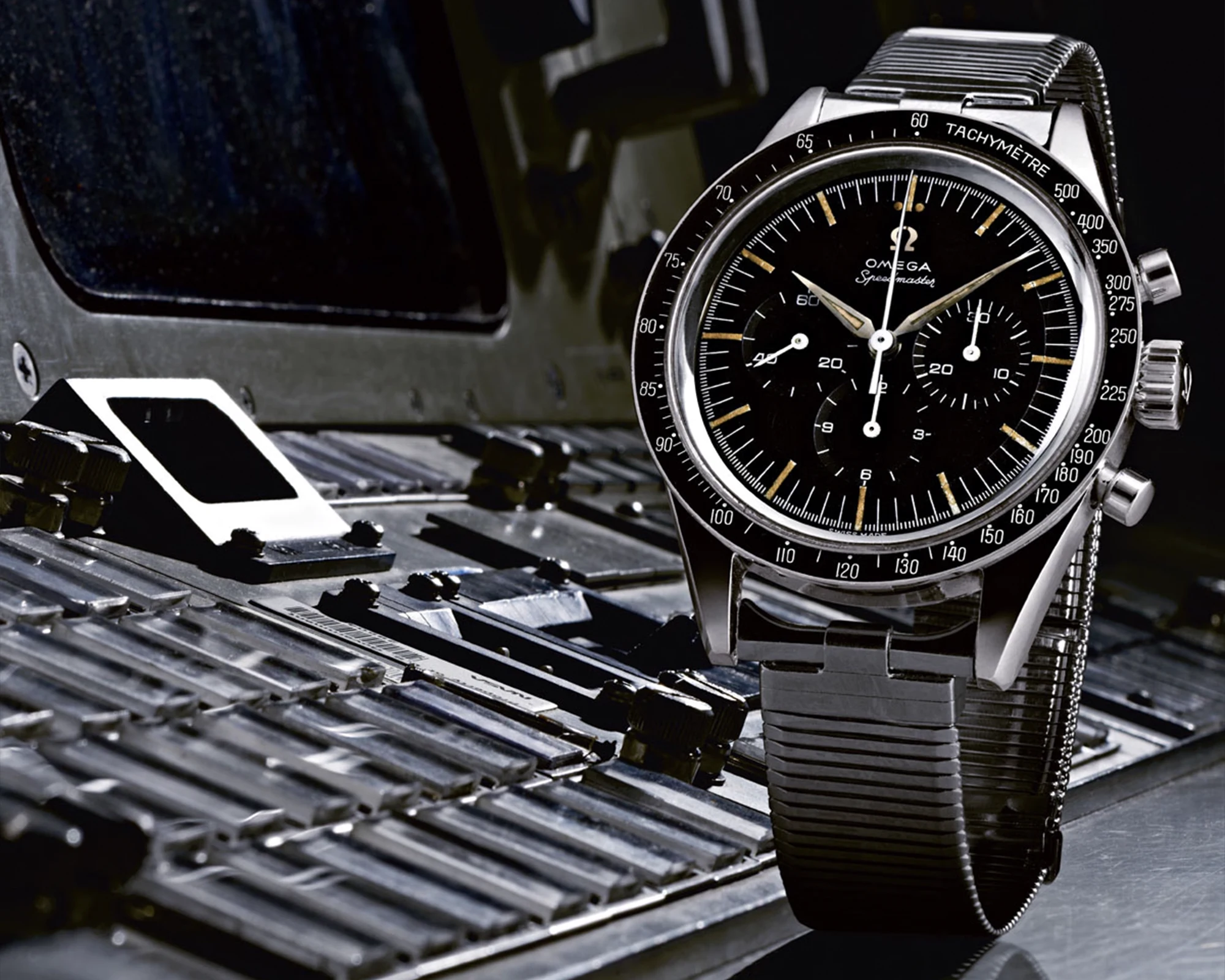
Wally Schirra’s Speedmaster-Chronograph
While the Ref. 145.012-68SP, which came under the hammer in 2022, was never deployed on a space mission, it was used for training purposes during the Apollo, Skylab, and Space Shuttle missions before being eventually sold as surplus. As one of the Speedmasters issued by NASA, it bears a special engraving with a part number (P/N) on the caseback and a serial number (S/N) on the central caseband. In the case of the Ref. 145.012-68SP, the engraving reveals the serial number ‘S/N 92,’ placing it only six numbers away from a similar Ref. 145.012-68 worn by Michael Collins during the Apollo 11 mission.

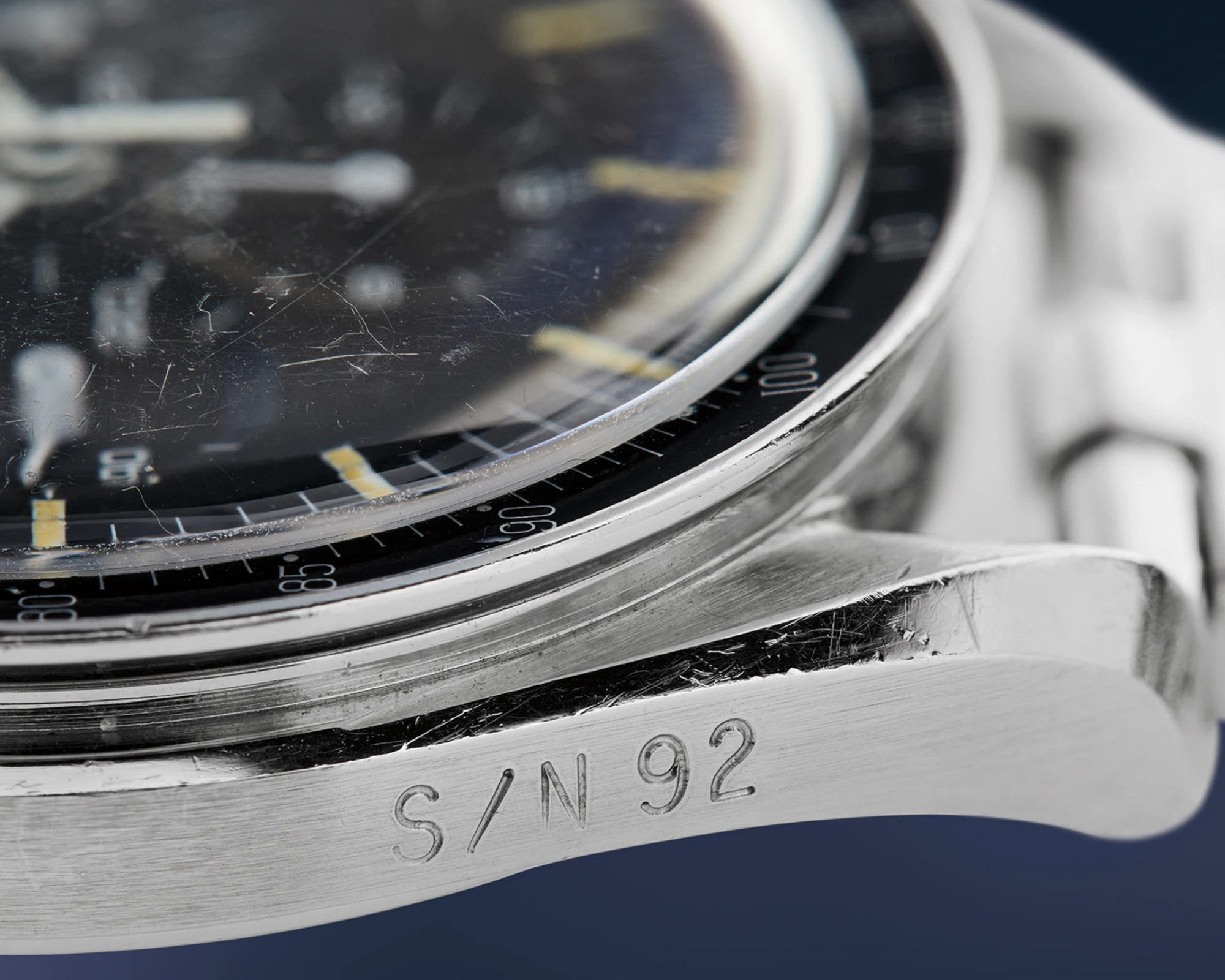
The Omega Speedmaster Professional Ref. 145.012-68SP from 1968
Credit © Phillips
The watch, which fetched an impressive approx. 277,229 CHF (327,600 USD) at the seventh edition of the New York Watch Auction in 2022, was accompanied by two Omega extracts, one of which was signed by James H. Ragan, a NASA programme manager and aerospace engineer. The extract confirms that the watch was delivered to NASA through Norman Morris, Omega’s U.S. agent at the time.
The eighth most expensive Omega watch: Ref. BA 345.0052.035
The Ref. BA 345.0052.035 elevated the concept of a space watch to an even higher level. It was part of the MIR collection, a series of 35 watches that spent 365 days on the MIR space station from July 1993 to July 1994. These watches were taken to the space station to study the long-term effects of microgravity on their movements. After a year in space, the watches were returned to Omega, all in impeccable condition. The collection comprised 35 watches with the following characteristics: 10 examples of Reference ST 145.0022.105.1 made of steel with leather straps, 18 examples of Reference ST 345.0022.105 made of steel with steel bracelets, 5 examples of Reference BA 145.0052.035A in gold with leather straps, and 2 examples of Reference BA 345.0052.035 in gold with gold bracelets.
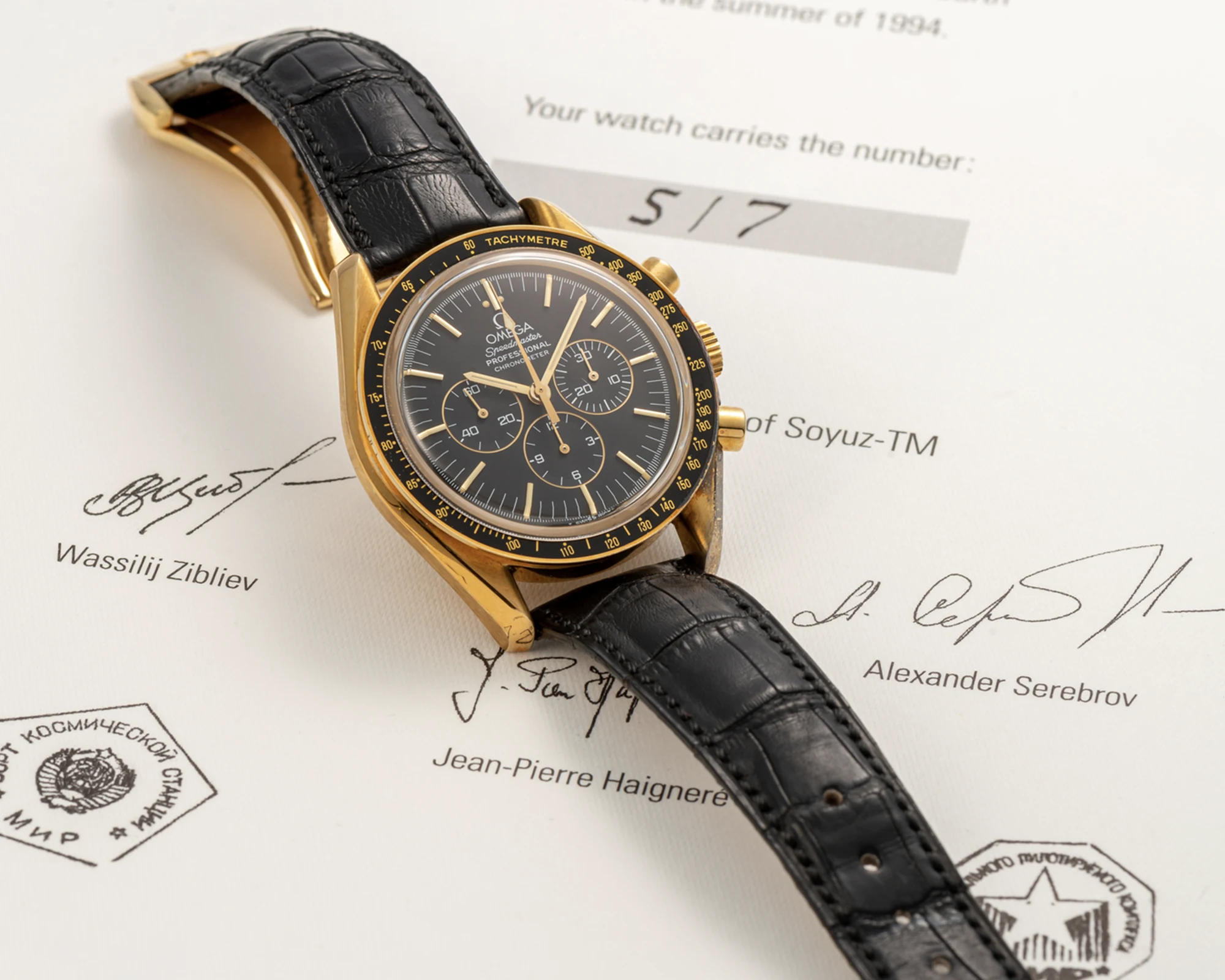
The Omega Speedmaster ‘MIR’, Ref. BA 345.0052.035, No. 5/7
Credit © Antiquorum
MIR (meaning ‘peace’ or ‘world’ in Russian) was a manned space station operated by the Soviet Union, which orbited the Earth from 1986 until its controlled descent in 2001. The station was assembled in orbit from several modules launched individually between 19 February 1986 and 1996. With the exception of two short periods, MIR was continuously occupied until August 1999.

Credit © Wikipedia
After the dissolution of the Soviet Union, a successful international cooperation ensued, including NASA. It culminated in the Shuttle-MIR Program, where Russian cosmonauts also travelled to the station aboard a shuttle. The Shuttle-MIR Program comprised eleven missions between 1994 and 1998, marking the first extensive collaboration in space between the superpowers of the United States and Russia since the Apollo-Soyuz project.
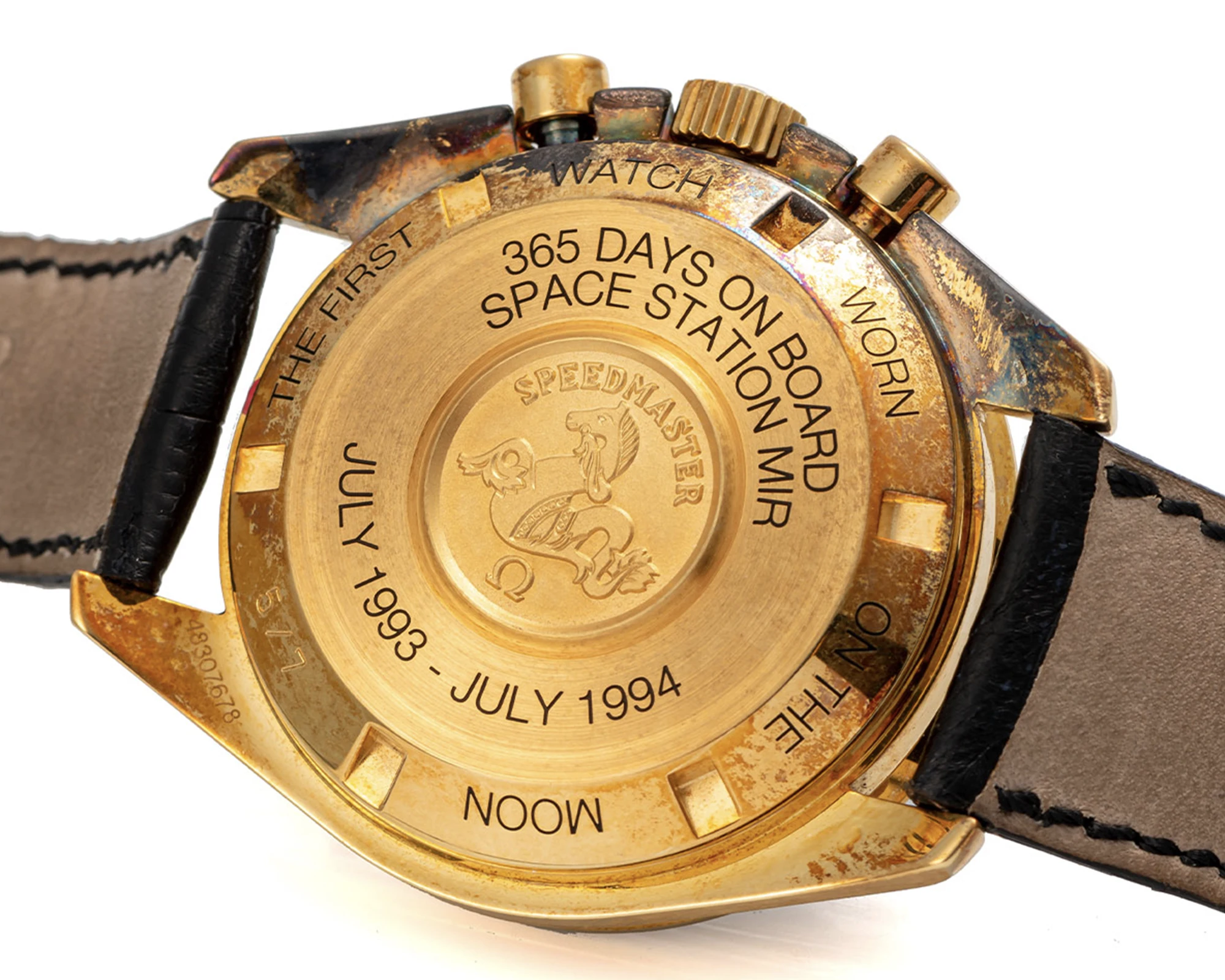
Credit © Antiquorum
To commemorate the Russian-American Atlantis-MIR rendezvous from 29 June to 3 July 1995, Omega released this special piece as part of the MIR collection to the public. The natural oxidation of the case has become an attractive feature of the watch. In 2022, the No. 5/7 example with a gold case fetched an impressive 312,500 CHF at the auction house Antiquorum.
7. Ref. 2915-1
In 2018, a rare iteration of the 2915-1 became the most expensive Omega Speedmaster ever sold at auction at the time thanks to an almost original dial that has taken on a deep, dark patina, luminous material that has aged to a rich, even shade of brown, and an original bezel.
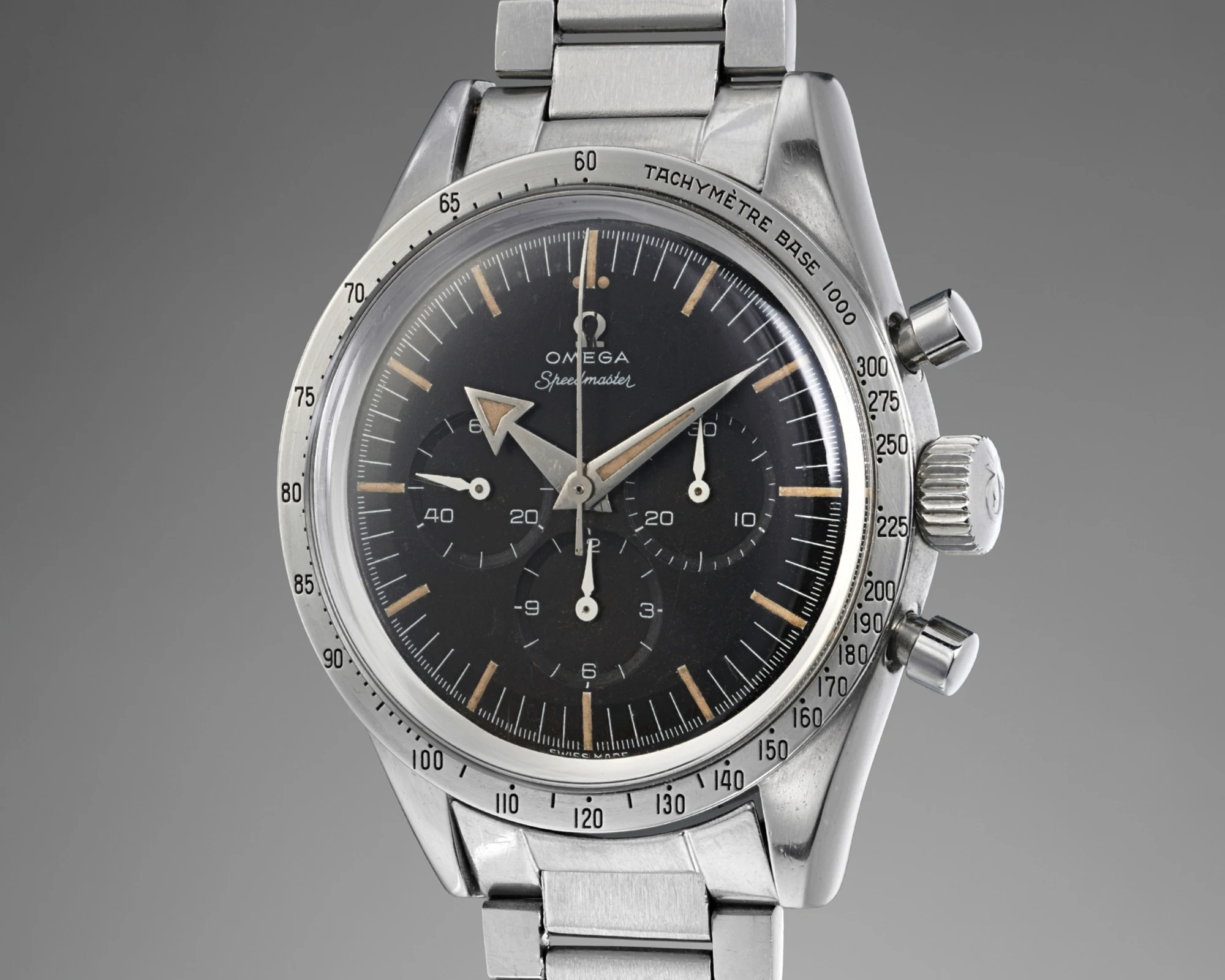
Die Ref. 2915-1
Credit © Phillips
According to the Omega archives, the watch was manufactured in 1958 and sold in Costa Rica later that year, on 17 December 1958. This year of manufacture comes with certain details that help explain the hefty price tag: the caseback, unlike modern models, does not feature the Seahorse engraving, possibly making it one of the last examples produced with this style of caseback.
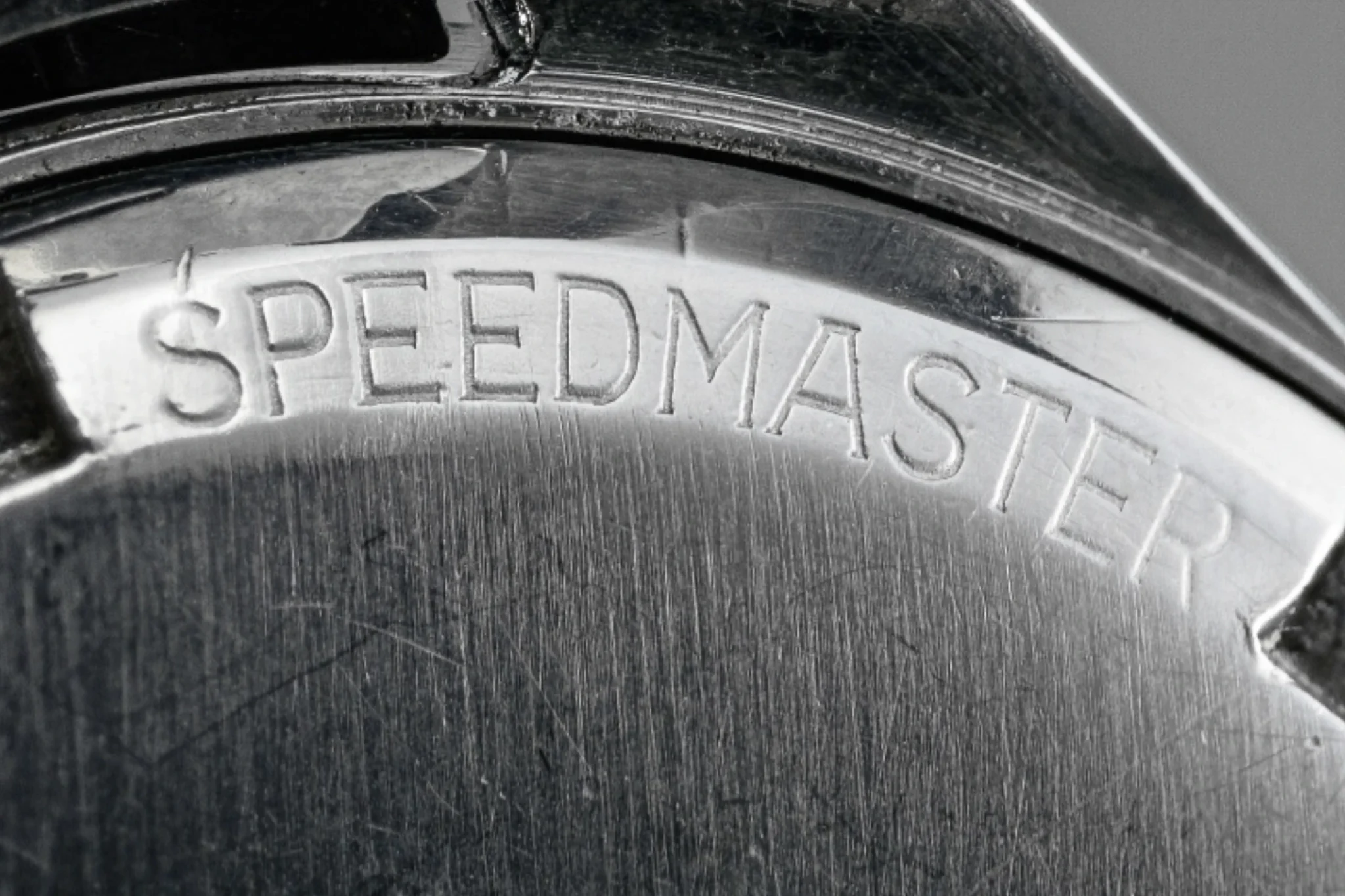
Credit © Phillips
As Phillips notes, the bezel, in contrast, is a Mark II version with a rounded 3 rather than a flat one. This is due to the fact that this model was halfway through production in mid-1958, which explains this rarer ‘transitional configuration’. Among collectors, these original bezels are so coveted that they are willing to pay tens of thousands of euros for a single bezel. Auction houses would also rather sell a 2915 without a bezel than risk having the watch later returned due to a counterfeit bezel.
All these features led to a remarkable auction price of 408,500 CHF for this early Ref. 2915-1, securing its place as the seventh most expensive Omega watch ever sold.
6. Chronometre à Tourbillon
The next timepiece among the most expensive Omega watches ever auctioned impresses not only with its elegant appearance but also with its remarkable origin story.
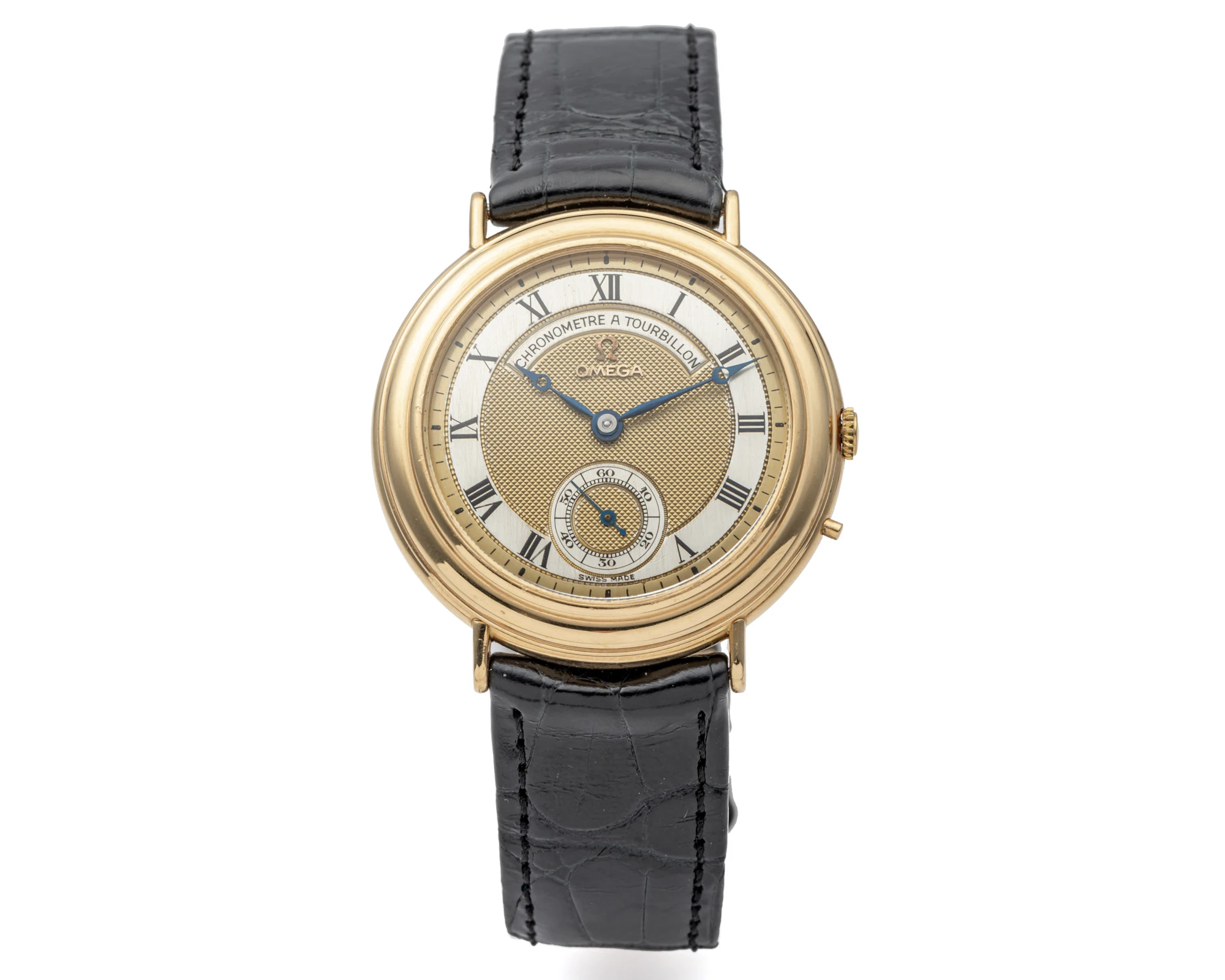
The Omega Chronometre à Tourbillon
Credit © Antiquorum
The movement of the Chronometre à Tourbillon was crafted by Jean-Pierre Matthey-Claudet, following designs by Marcel Vuilleumier. The latter was a specialist in tourbillon constructions and the director of the watchmaking school in Le Sentier in the Vallée de Joux. In 1947, he developed the movement for Omega. Unlike the typical one-minute rotation seen in most tourbillon mechanisms, this Chronometre à Tourbillon featured a 7½-minute rotation. Omega produced only 13 of these chronometer movements, with 12 being exclusively intended for observatory’s precision competitions. Some of these watches, regulated by Alfred Jaccard, the chief regulator at Omega’s Biel factory, achieved outstanding results in competitions held between 1947 and 1952 in Kew Teddington (London), Neuchatel, and Geneva. One such piece, serial number 10,595,933, won 867.7 points at the Geneva Observatory competition in 1950, the highest score ever achieved in the category of individual wristwatches at that time.
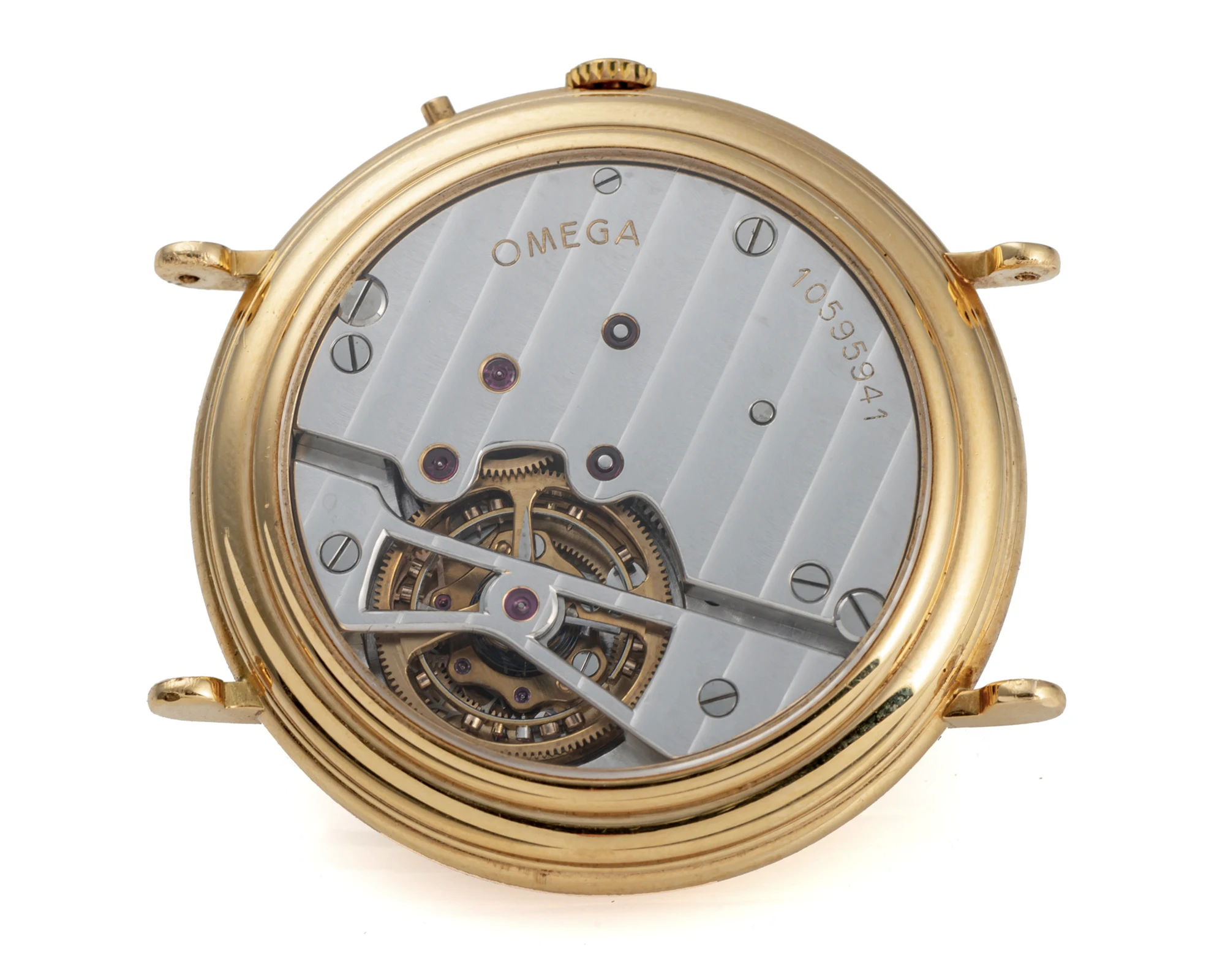
The calibre 30 I
Credit © Antiquorum
One of these 13 movements, the one that claims the 6th spot on our list of the most expensive Omega watches, was restored by none other than the then 29-year-old Frank Muller. At the time, Muller was working as a freelance watchmaker for brands such as Patek Philippe, but just a few years later, he would rise to prominence and launch his own eponymous brand.
Muller was also played a crucial role in this timepiece’s design as he commissioned the Geneva-based company Tille for the dial. Furthermore, he had the special 39.5 mm case in 18-karat yellow gold with a sapphire case back made by Jean-Pierre Hagmann, the renowned case maker for Patek Philippe, who today co-operates the JHP x AkriviA Atelier in Geneva.
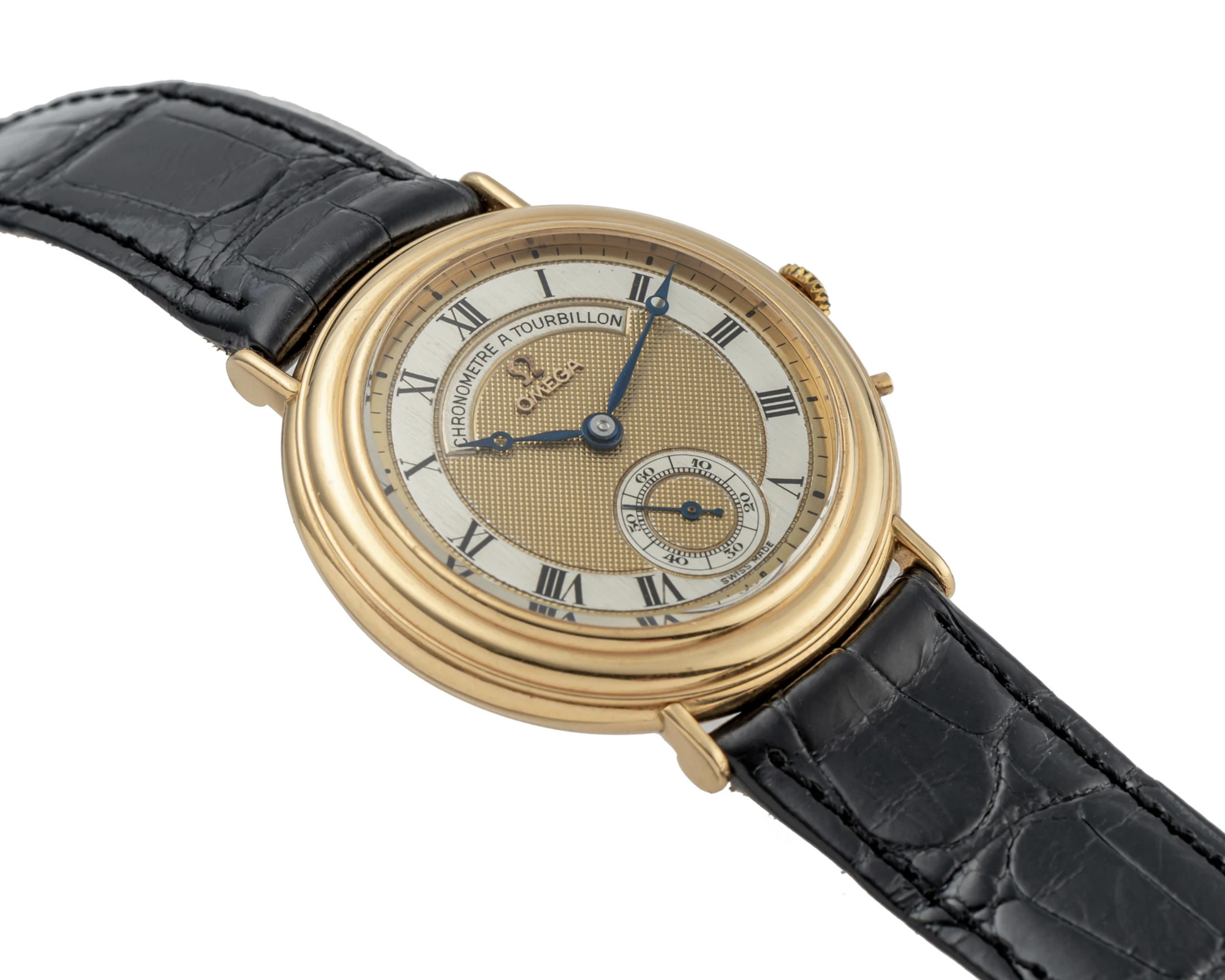
The movement dates back to 1947 and was fitted into the case in 1987
Credit © Antiquorum
Thus, these efforts resulted in the creation of the Chronometre à Tourbillon, which fetched an impressive 512,500 CHF at the Antiquorum auction in 2021.
The fifth most expensive Omega watch: Ref. 145.022 “Alaska Project”
The Ref. 145.022 ‘Alaska II’ originates from the ‘Alaska Project’, a series of four watch models designed by Omega with the goal of supplying NASA with space-ready timepieces and ultimately creating the perfect space watch. Reportedly, Omega chose the codename ‘Alaska’ to ensure that this secret project would maintain a low profile in the event of industrial espionage.
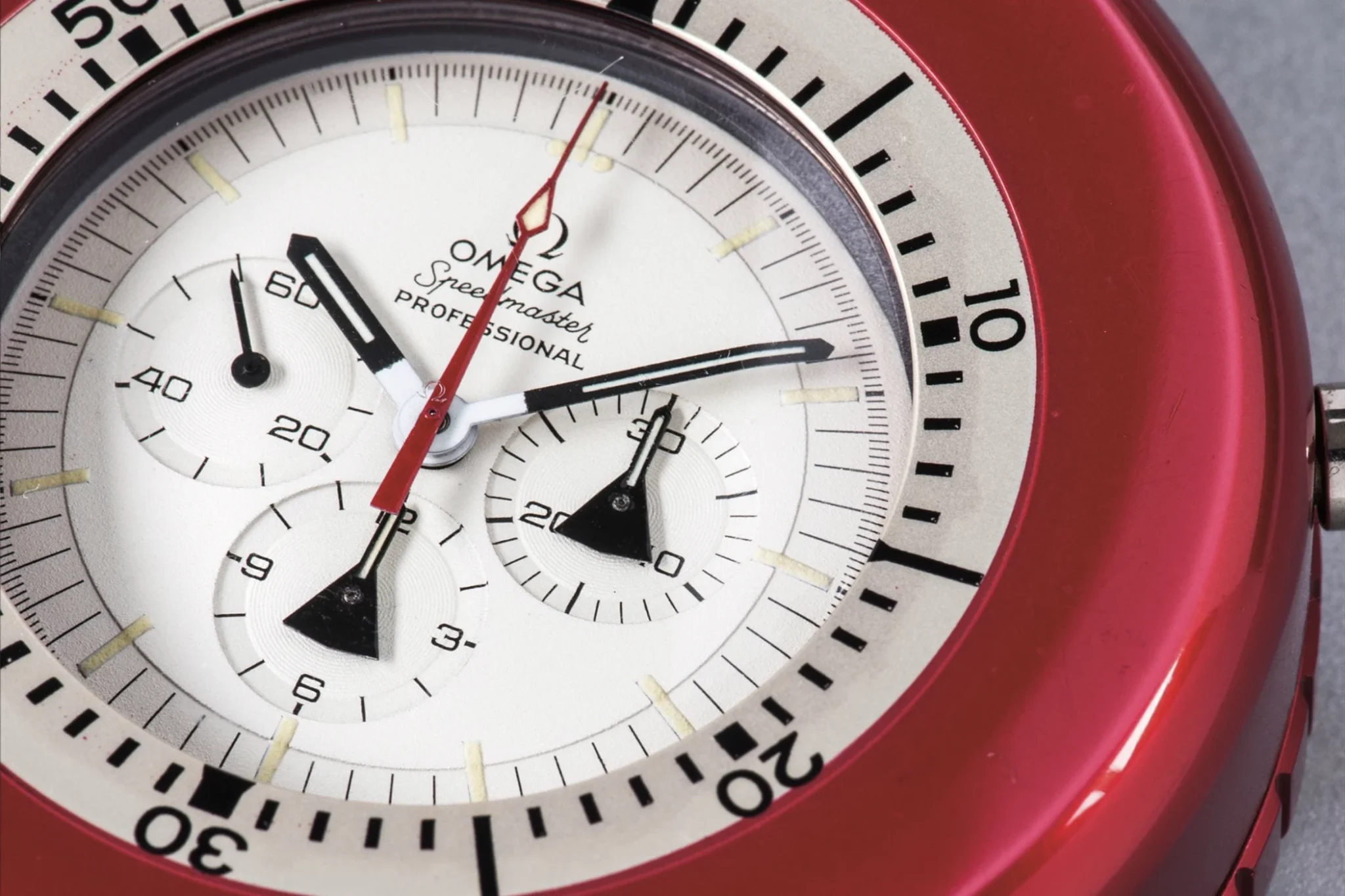
The Omega Speedmaster Professional, ‘Alaska II’ project watch Ref. 145.022-69
Credit © Phillips
The very first prototype, the Speedmaster ‘Alaska I’ (Ref. 5-003), was developed in 1969, the year of the moon landing. It was characterized by an oversized 46 mm titanium case, surrounded by a removable outer shell made of red anodized aluminium. This protective shell, also known as a thermal shield, was designed to block sunlight and protect the mechanical interior from heat. This was necessary because the Moon, lacking an atmosphere, cannot retain heat, causing temperatures to vary dramatically with the time of day. During the lunar day, temperatures can soar to about 127°C, while at night, they can plummet to around -173°C.
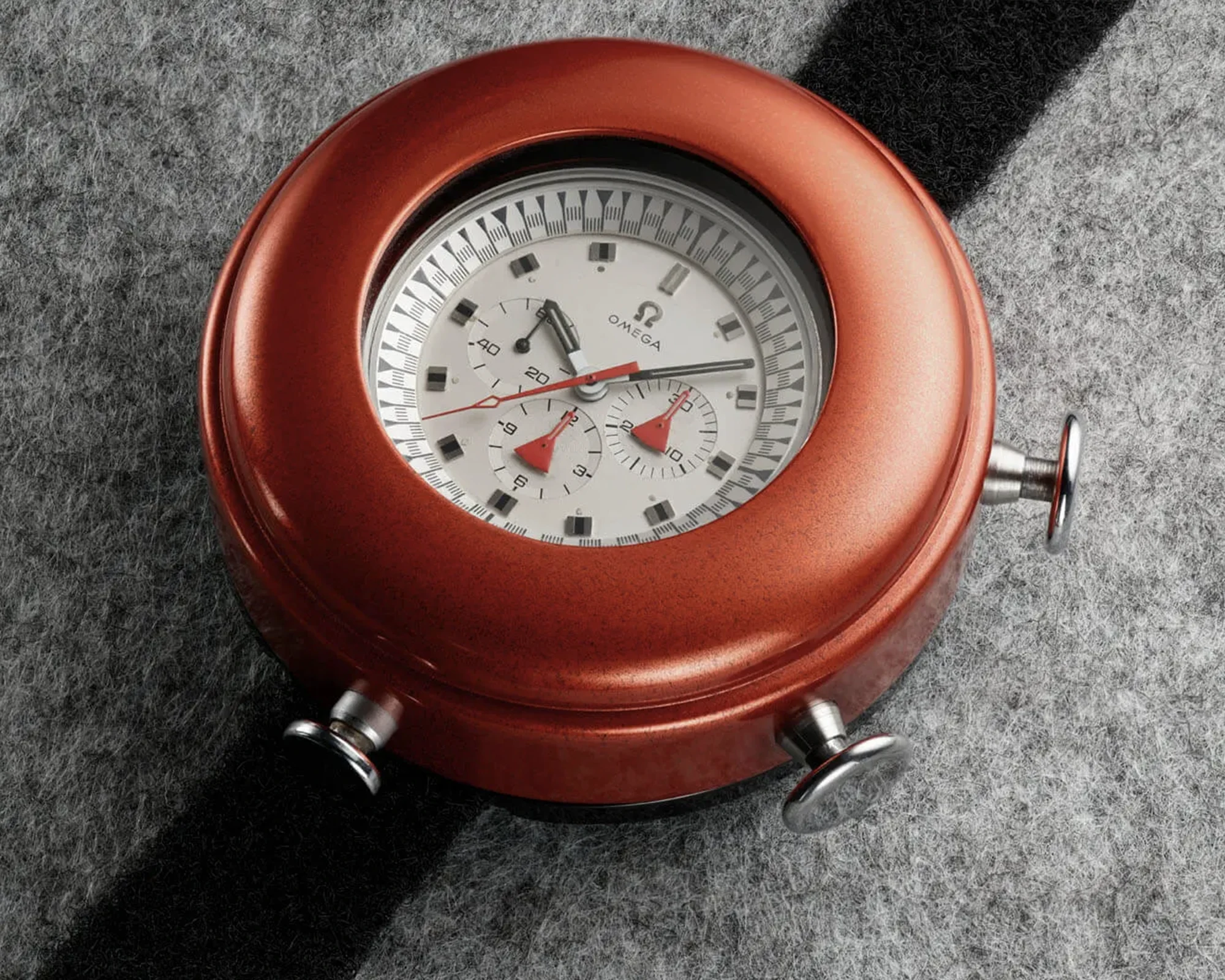
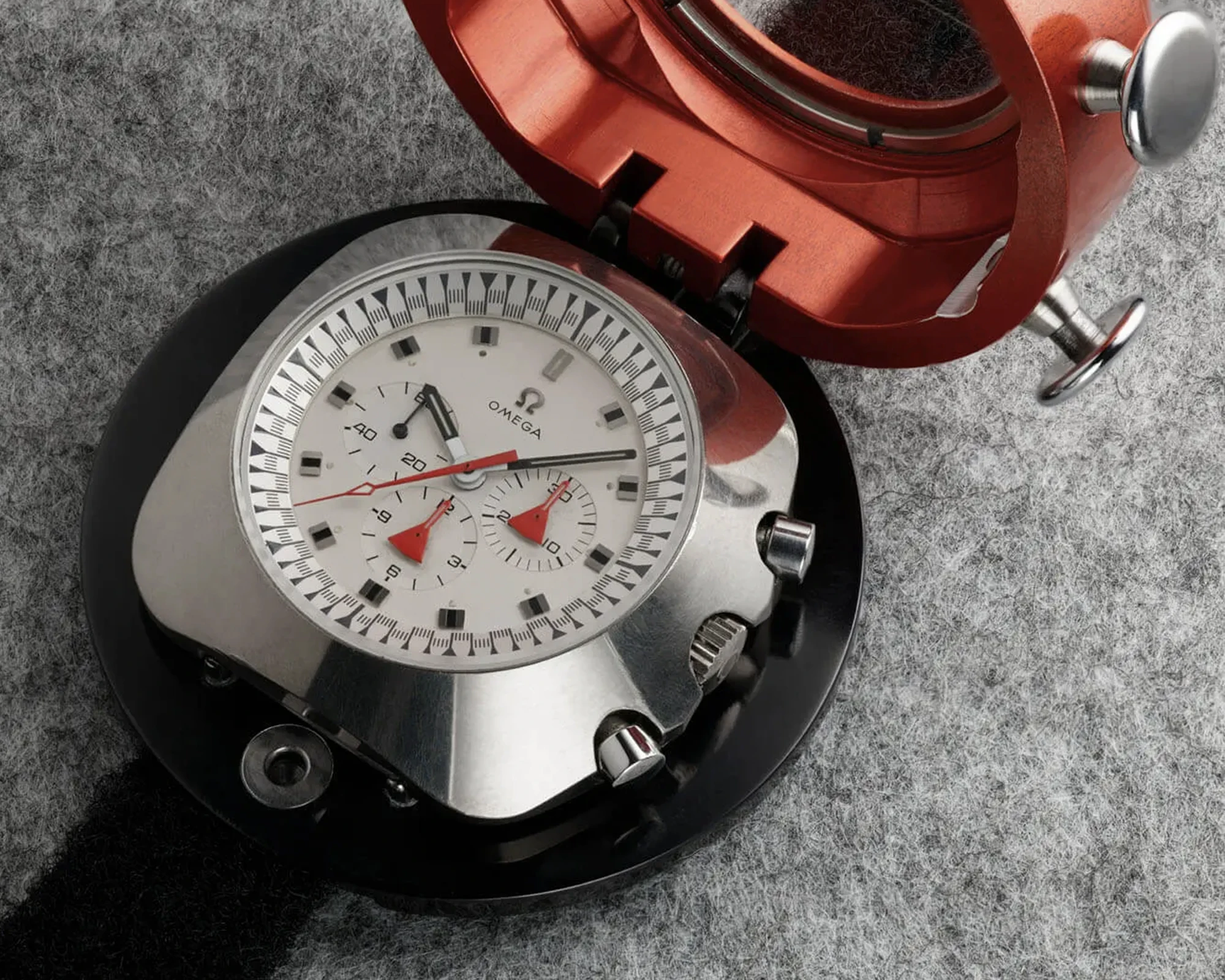
The Omega Speedmaster ‘Alaska I’ Ref. 5-003
In the early 1970s, Omega continued with the project and internally referred to it as ‘Alaska II.’ The fifth spot on our list of the most expensive Omega watches belongs to the first batch of ‘Alaska II’ prototypes, delivered around 1970. This timepiece combined the technologies and insights gained from ‘Alaska I’ with the Speedmaster ‘Moonwatch’ case. It featured a white dial with oversized ‘Apollo’ hands on the sub-dials, and the red thermal shield was also included once again. The ‘Alaska II’ test watches were sent to Houston in the early 1970s, but as the Apollo program came to an end in 1972, the watches were not retained by the program office. Once again, Omega’s Alaska projects came to a halt.
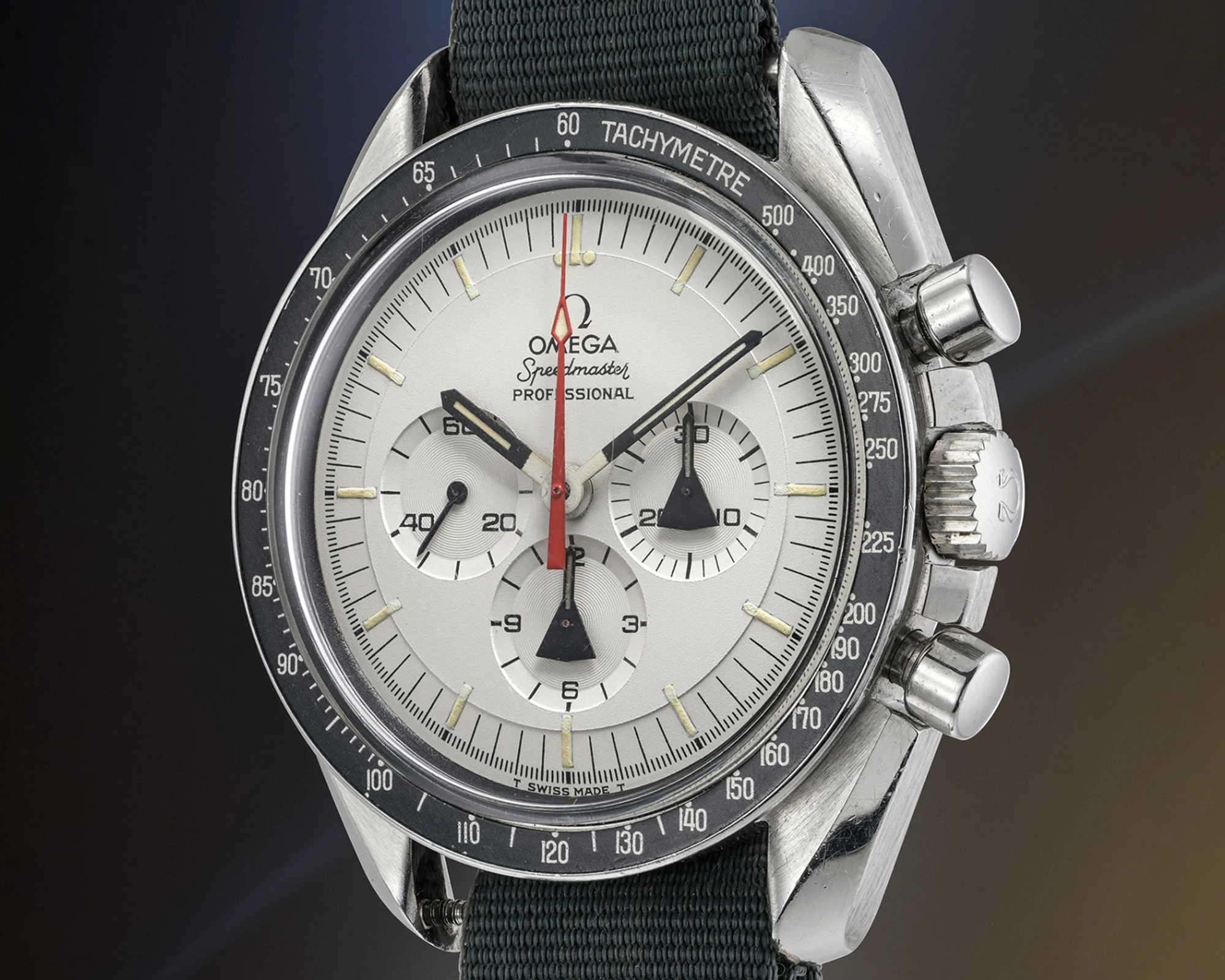
No. 5: The Ref. 145.022 ‘Alaska Project’
Credit © Phillips
Due to the high limitation of this timepiece and the practically flawless condition of its dial, the Ref. 145.022 ‘Alaska Project’ achieved an auction price of 529,200 CHF.
4. Ref. 145.012-67 SP
This timepiece once graced the wrist of Ralph W. Ellison (1914–1994), a prominent American writer. Although it remains unclear whether Ellison received this Speedmaster as a gift or purchased it himself, it is known that shortly after the watch was delivered to the United States in 1968, as confirmed by an extract from the Omega archive, Ellison was interviewed and photographed wearing it in Riverside Park. He wore the watch for the remainder of his life, even after the upper chronograph pusher had fallen off. The Speedmaster was his companion on the wrist for the next twenty-five years until his death in 1994.
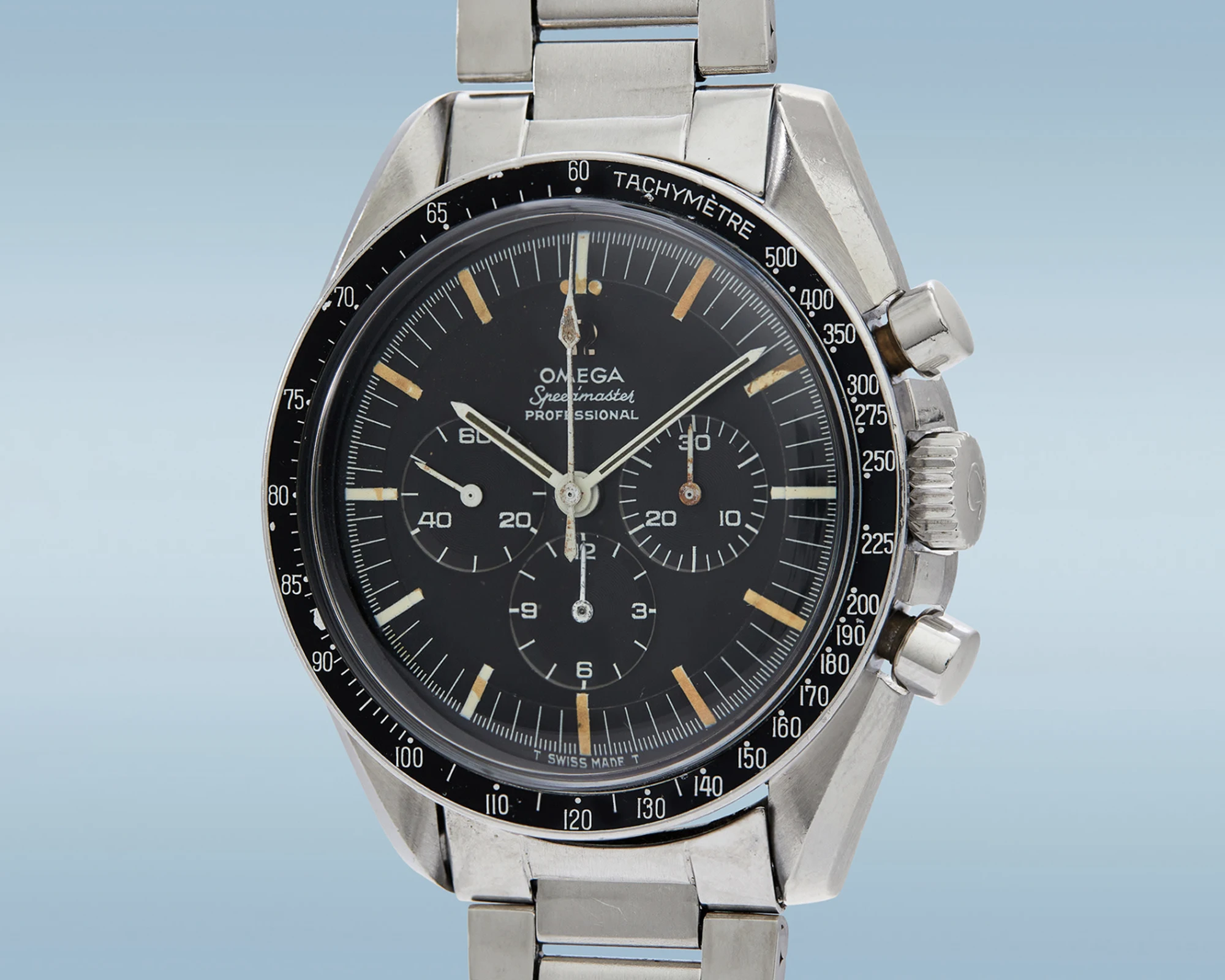
The Ref. 145.012-67 SP
Credit © Phillips
In December 2021, this historic piece fetched an impressive price of approx. 565,513 CHF (667,800 USD) at Phillips auction house.
3. ‘Tourbillon 30 I’
Featuring a tourbillon escapement and a Guillaume balance, this timepiece sheds new light on the history of this complication as a wristwatch. As previously mentioned, Omega created thirteen calibre 30 I tourbillon movements in 1947, each with a diameter of only 30 mm. They were tested in the ‘wristwatch’ category at the observatories of Geneva, Neuchâtel, and Kew-Teddington. In 1987, Omega rediscovered seven of these thirteen movements and fully restored them, encasing them in gold and silver, and offering them to a select group of collectors.
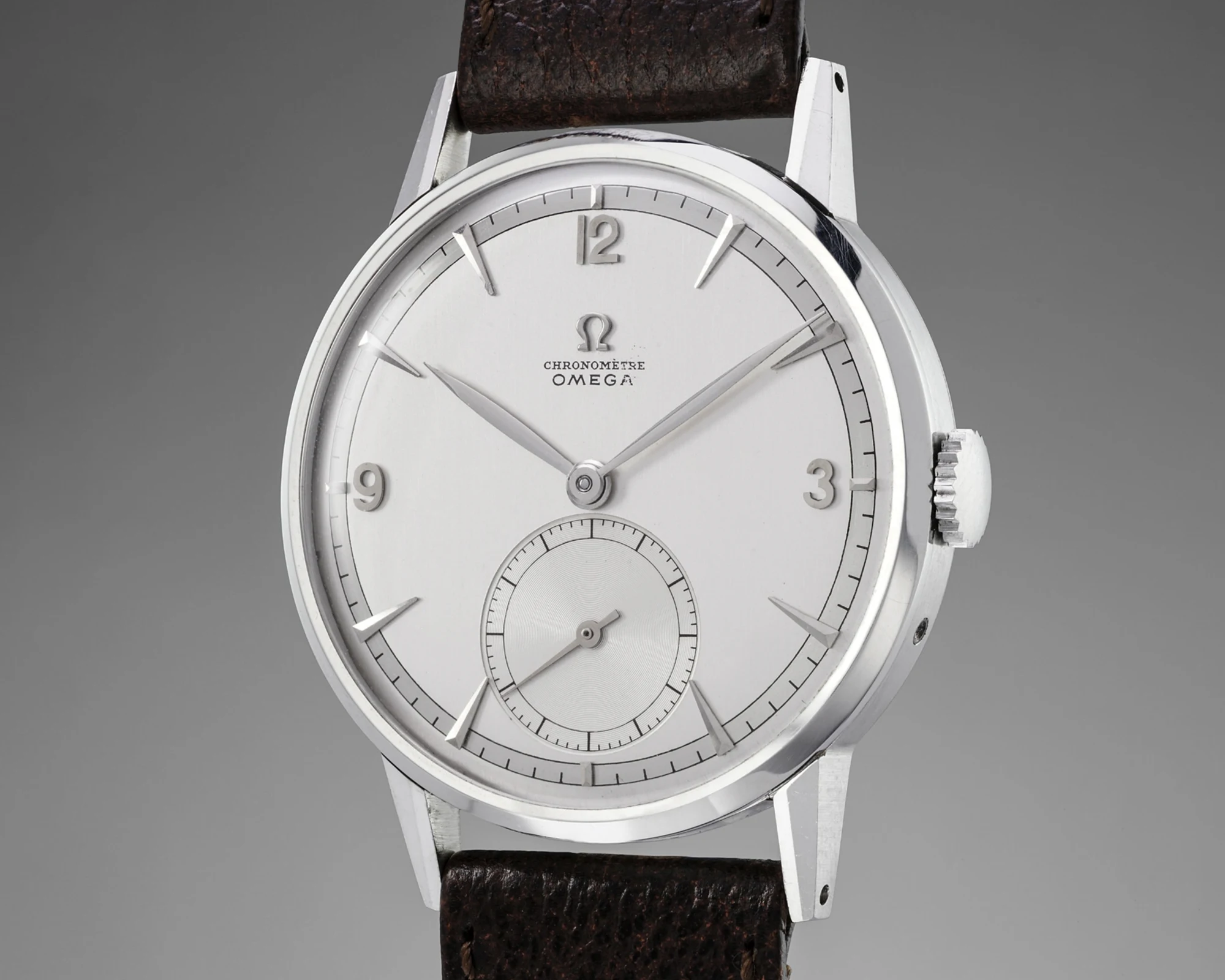
The “Tourbillon 30 I” from 1947
Credit © Phillips
However, while it was always believed that these movements were created solely for precision competitions at observatories, images and information contained in a 1947 letter preserved in the Omega Museum reveal a previously unknown fact: Marcel Vuilleumier, head of the watchmaking school in the Vallée de Joux, who was concerned about the arrival of American and British timepieces, emphasised the need for the Swiss watch industry to focus on precision watches and proposed the development of a tourbillon wristwatch. An original drawing from 1947, recently discovered, illustrates his idea of a prototype: a serial-produced wristwatch integrating the calibre 30 I tourbillon movement.
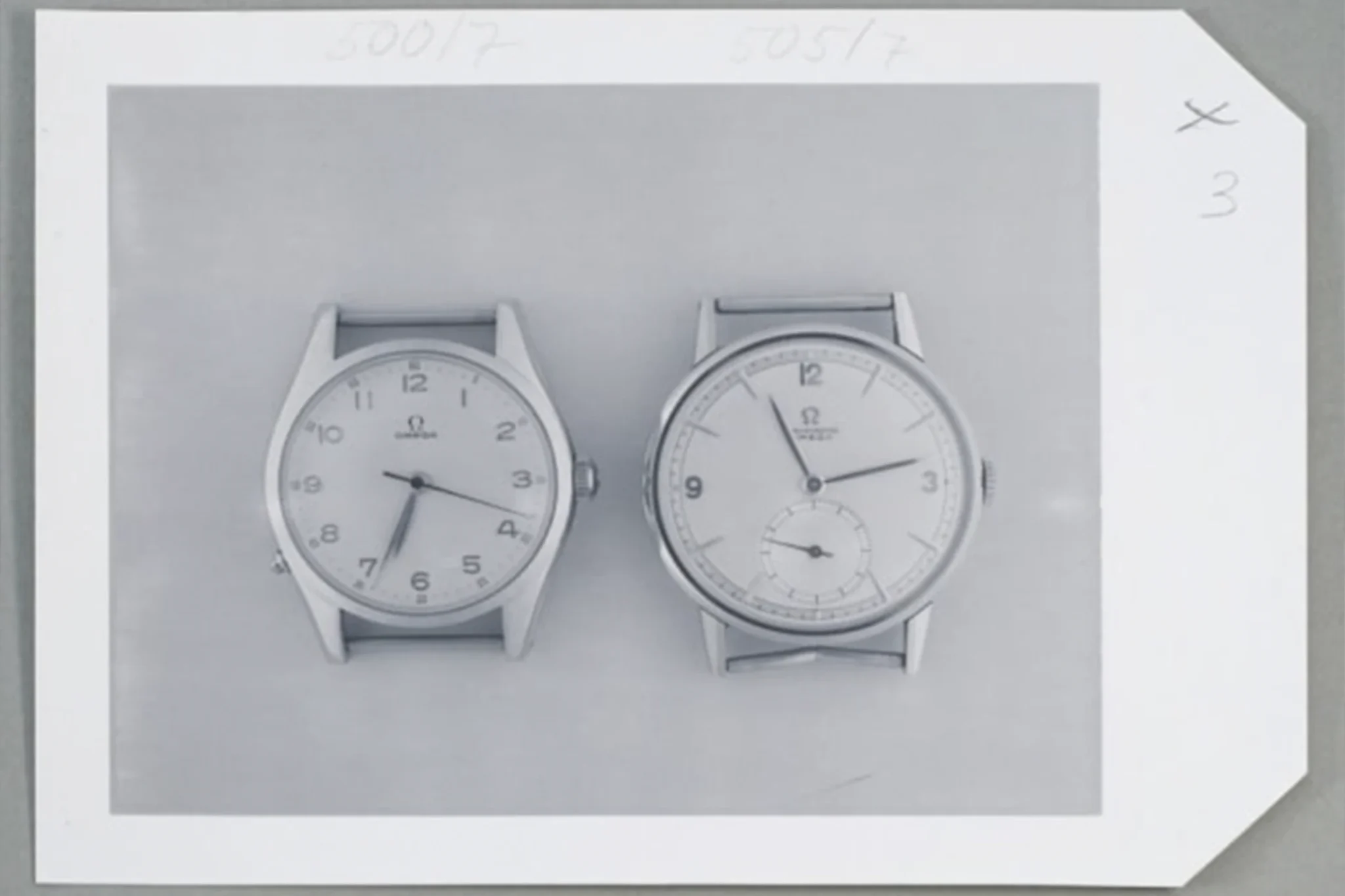
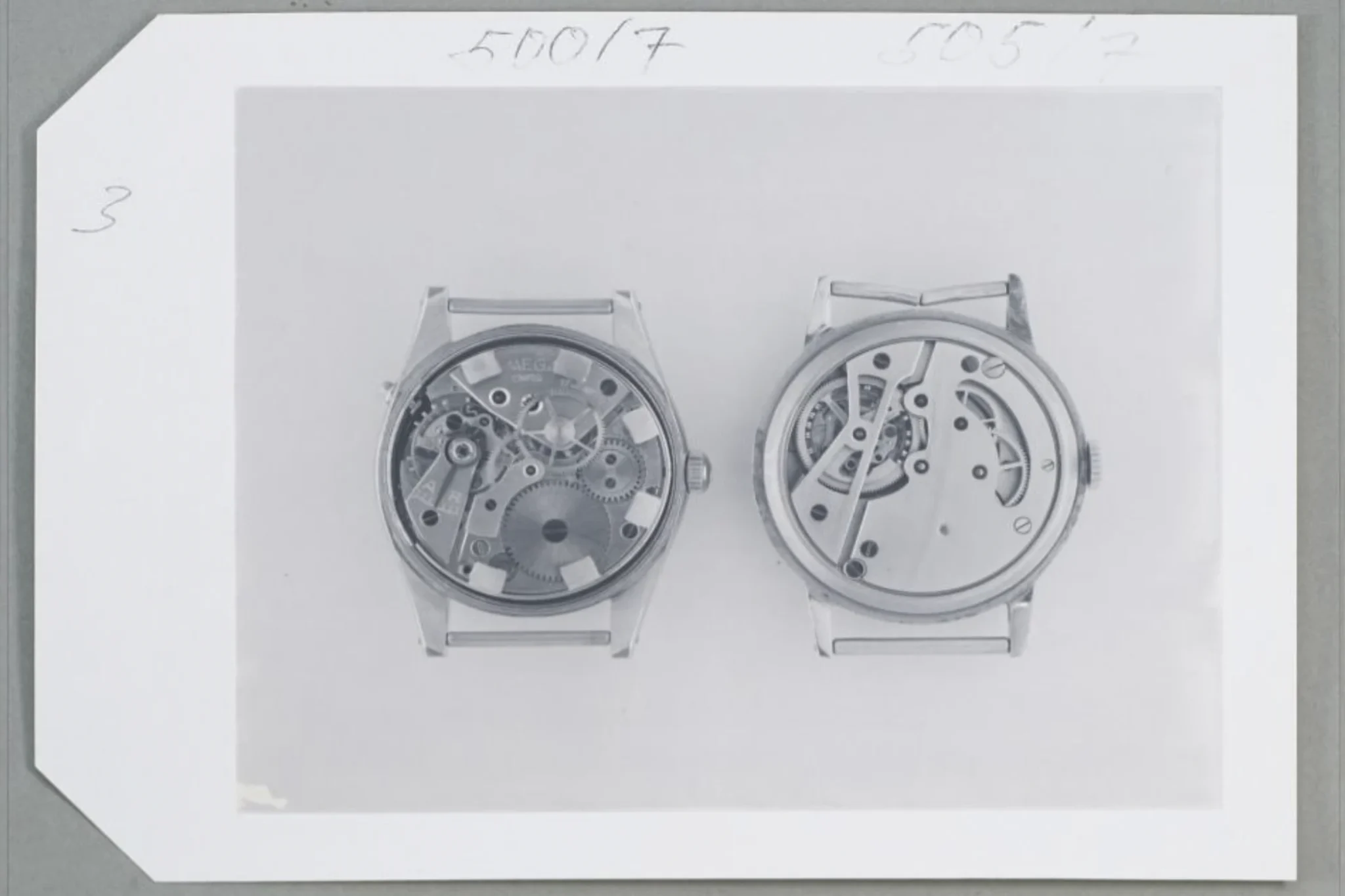
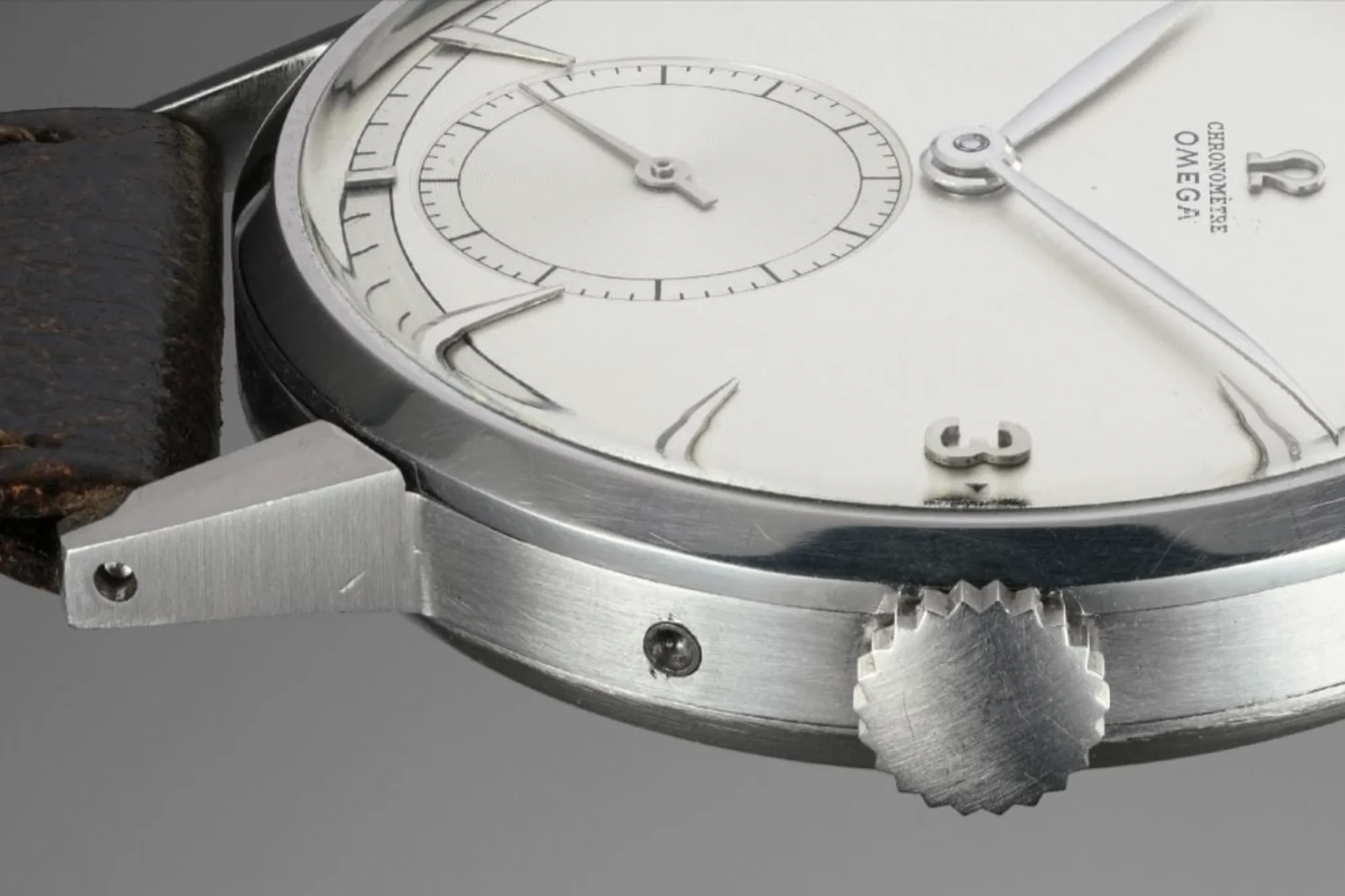
Credit © Phillips
The third entry on our list of the most expensive Omega watches confirms that this idea was indeed brought to life, as this is the very first prototype in a series of Omega wristwatch tourbillons, which, however, never went into serial production. Due to its historical significance and its extreme rarity, this prototype achieved an auction price of 1,428,500 CHF in 2017.
The second most expensive Omega watch: Ref. H6582/D96043
The allure of Elvis Presley can only be truly understood when we consider that his music represented a profound cultural shift. The young Presley meticulously studied the vocal styles of African American artists like Big Joe Turner and Louis Jordan, whom he listened to on the radio in Memphis, just as thoroughly as he did the white country singers. These artists deeply influenced Presley and he discovered the blueprint for his own musical legacy in their work. But it wasn’t just their vocal styles he adopted; he also embraced the raw emotion and dance that were largely absent from mainstream media at the time. In the eyes of the old guard during Eisenhower-era America, this was nothing short of an affront – yet for others, it was nothing less than a cultural revolution.
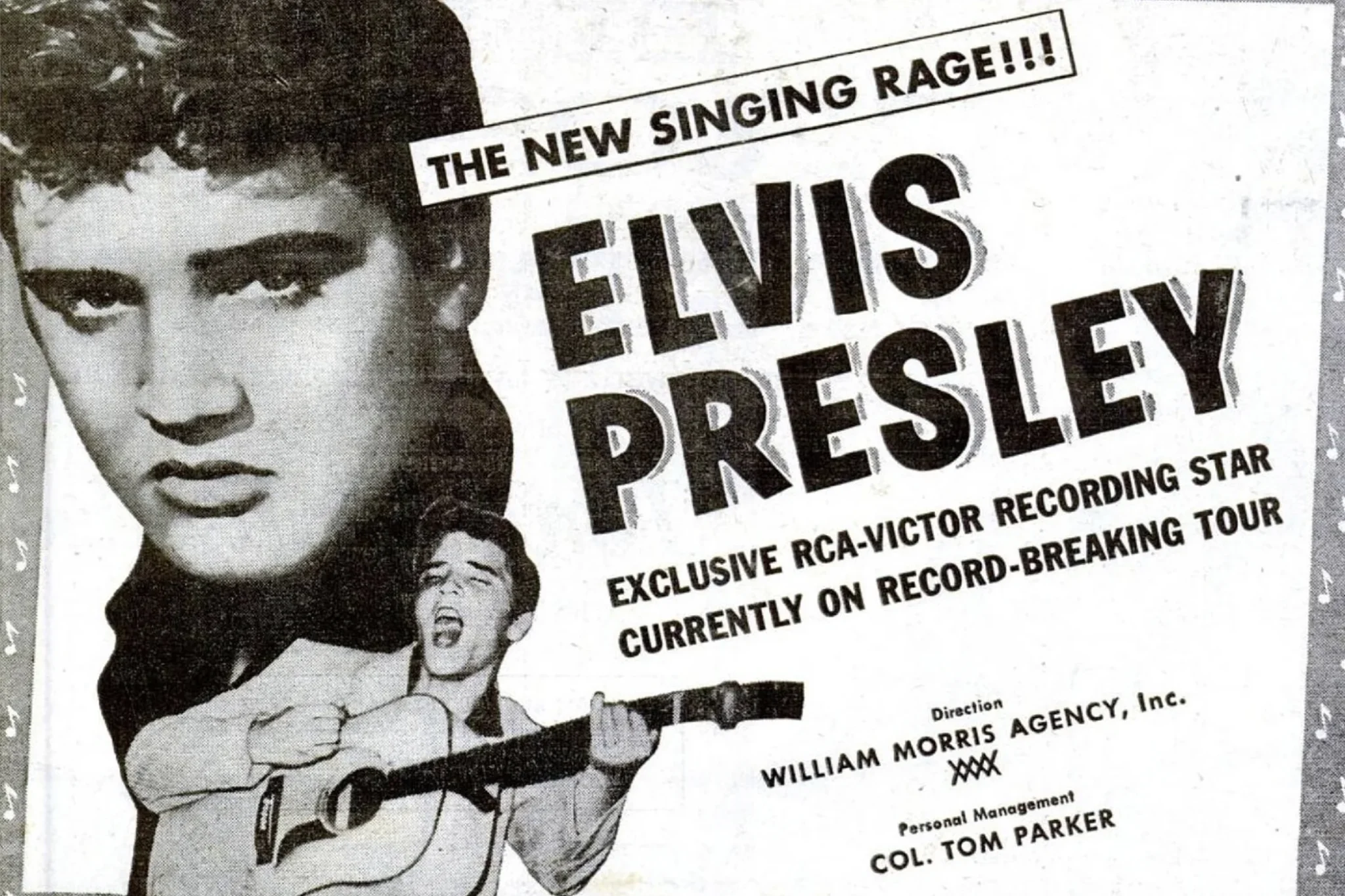
Billboard advertising Elvis Presley, 10 March 1956
Credit © Wikipedia
This eventually led to the now-famous TV networks’ decision to only film Presley from the waist up. However, it was these very images that left a deep imprint on the public consciousness: for some, his presence on screen evoked ecstasy, understandable only through erotic or even religious terms, while for others, he represented a disquieting, distant world. This contradiction would forever leave a mark on America: a nation both captivated by and resentful of an icon who simultaneously fascinated and threatened the established order.
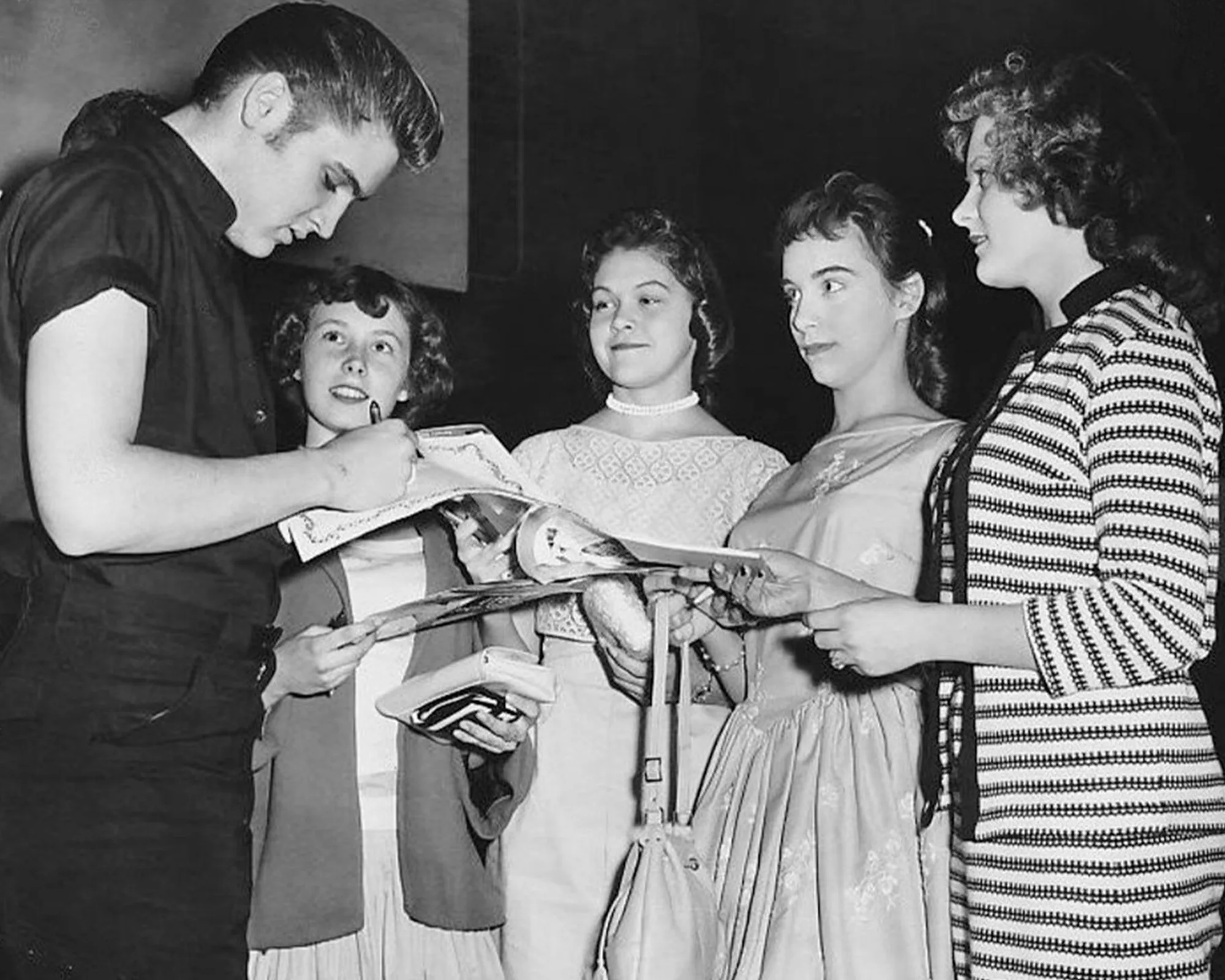
Credit © Wikipedia
Following his breakthrough in 1956, 1960 would prove to be an especially eventful year for Elvis’s burgeoning popularity. In March and April of that year, Elvis not only recorded ‘Elvis is Back!’, which was released on 8 April 1960, but also saw two of his films, Flaming Star and G.I. Blues, enjoying box office success. Moreover, his single ‘Are You Lonesome Tonight’ topped the charts in the United States, and by 25 December 1960, Elvis had achieved 75 million record sales worldwide.
To commemorate this milestone, Elvis’ record label RCA Records held a celebratory dinner in February 1961. During this event and in the presence of the Governor of Tennessee and the Mayor of Memphis, RCA Records presented Presley with a commemorative plaque, recognizing the 75 million records sold worldwide. This plaque, which is still kept at Graceland, was accompanied by a Tiffany-signed Omega wristwatch with a bezel set with forty-four diamonds—an extraordinary timepiece that would become the second most expensive Omega watch ever sold.
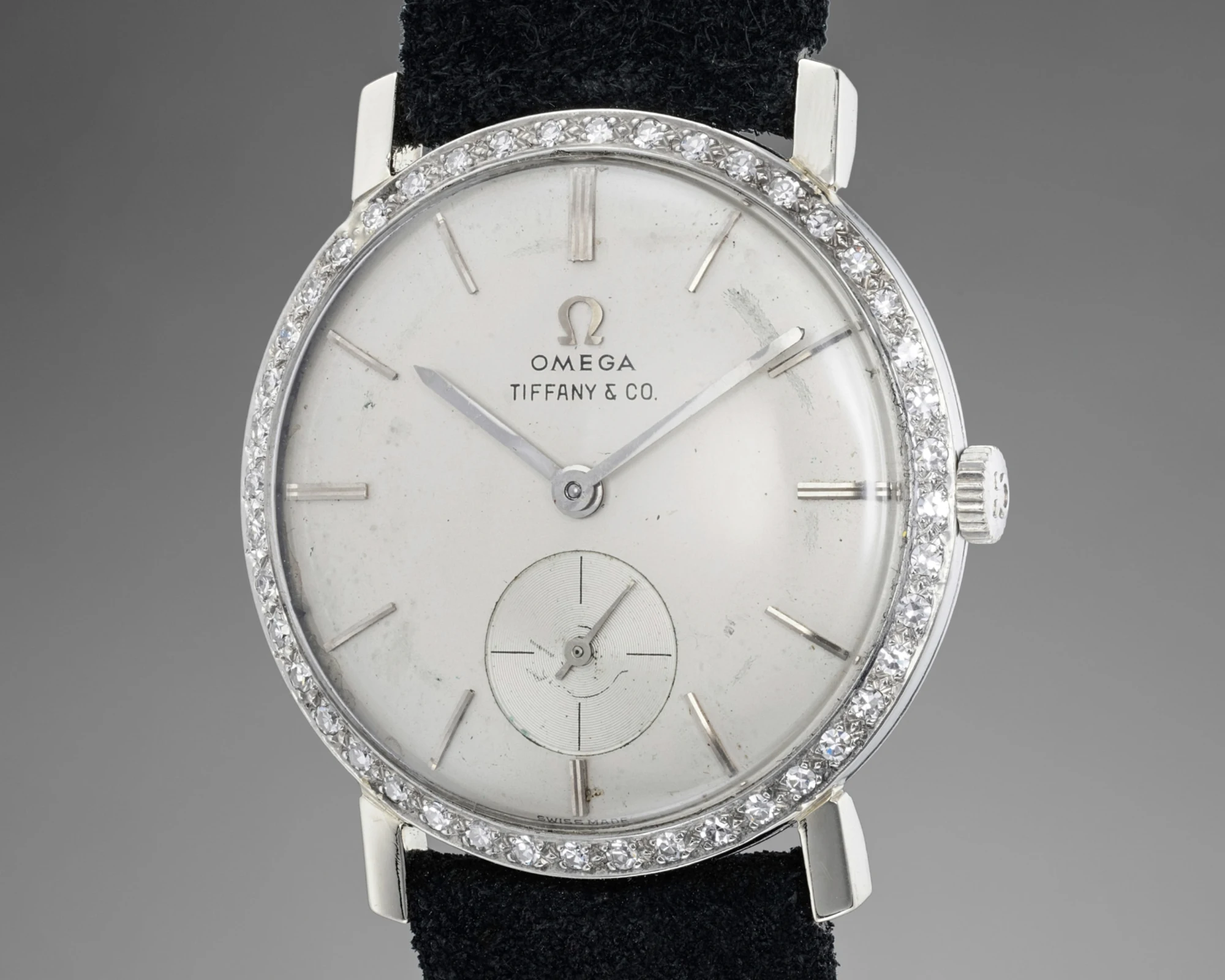
Elvis Presley’s Ref. H6582/D96043 from 1960
Credit © Phillips
Crafted by the American case manufacturer Jonell Watch Case Company, Inc. in Long Island City, New York, the watch case bears the following inscription on the case back:
“To Elvis
75 Million Records
RCA Victor
12-25-60”
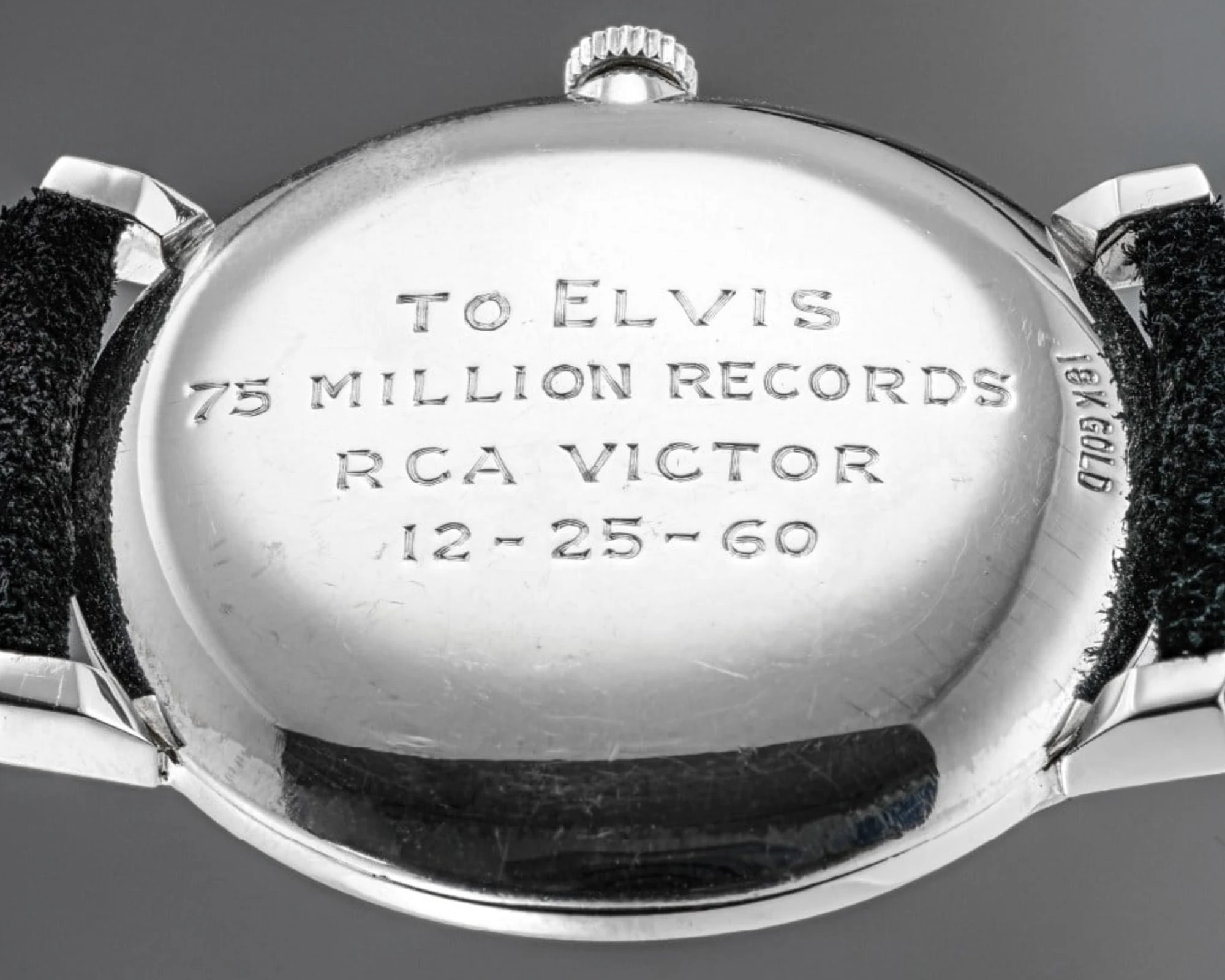
Credit © Phillips
According to Phillips, Elvis traded in a diamond-encrusted Hamilton watch for the Omega, which later fetched an auction price of 1,812,500 CHF, securing its spot as the second most expensive Omega watch of all time.

Credit © Phillips
1. The Most Expensive Omega Watch: Ref. 2915-1
On 5th November 2021, a dramatic and rather extraordinary event took place at Phillips Auction House in Geneva: an Omega Speedmaster Ref. 2915-1, featuring a rare so-called “tropical” dial, was up for auction.
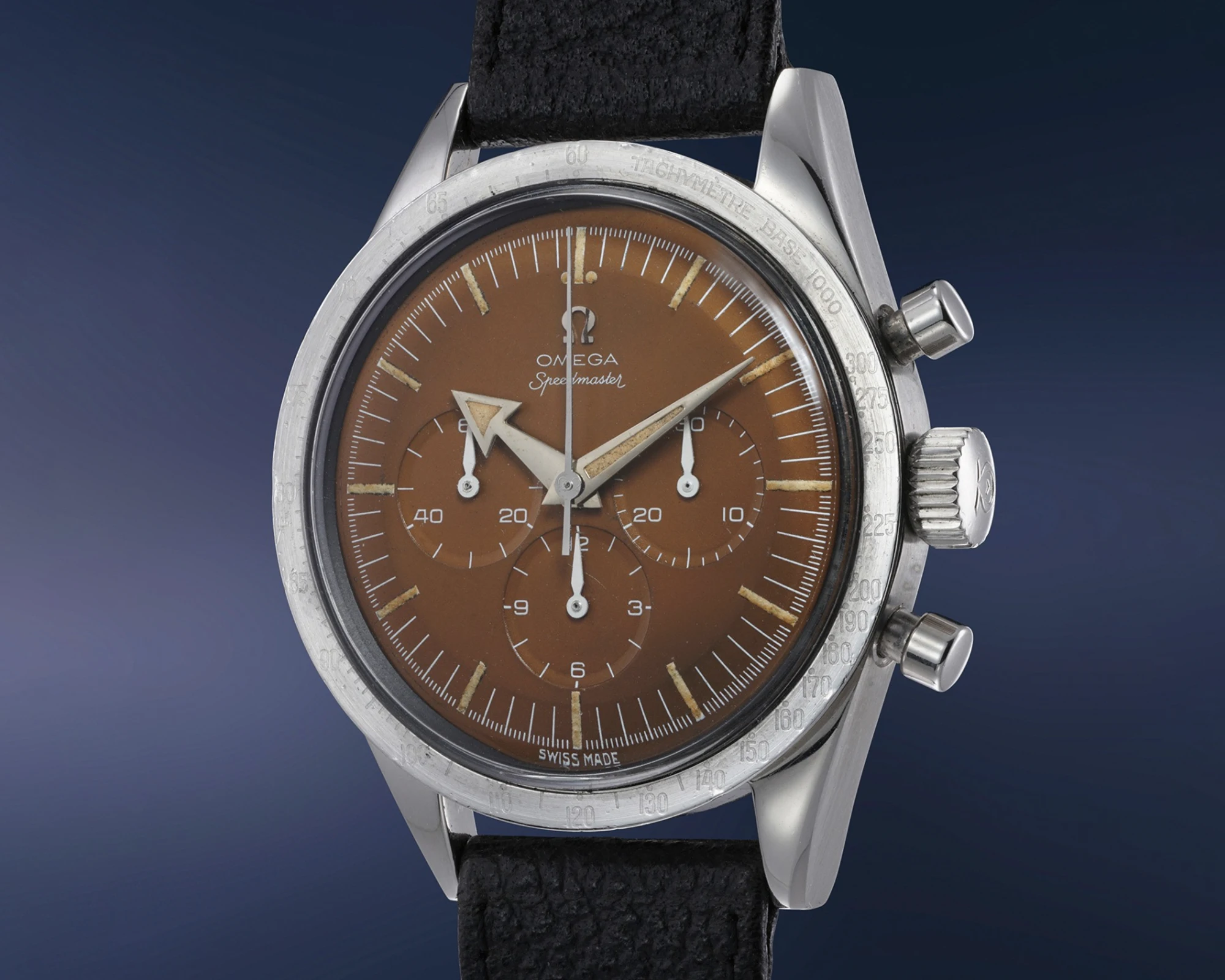
Ref. 2915-1: The most expensive Omega watch of all time
Credit © Phillips
On paper, the watch presented itself as an exceptionally appealing package: a once-black dial that had mellowed into a rich brown hue due to sun exposure, luminous material on the dial and hands that had aged to an attractive golden tone, and the overall excellent condition of the watch made it the epitome of what collectors seek in a Speedmaster.
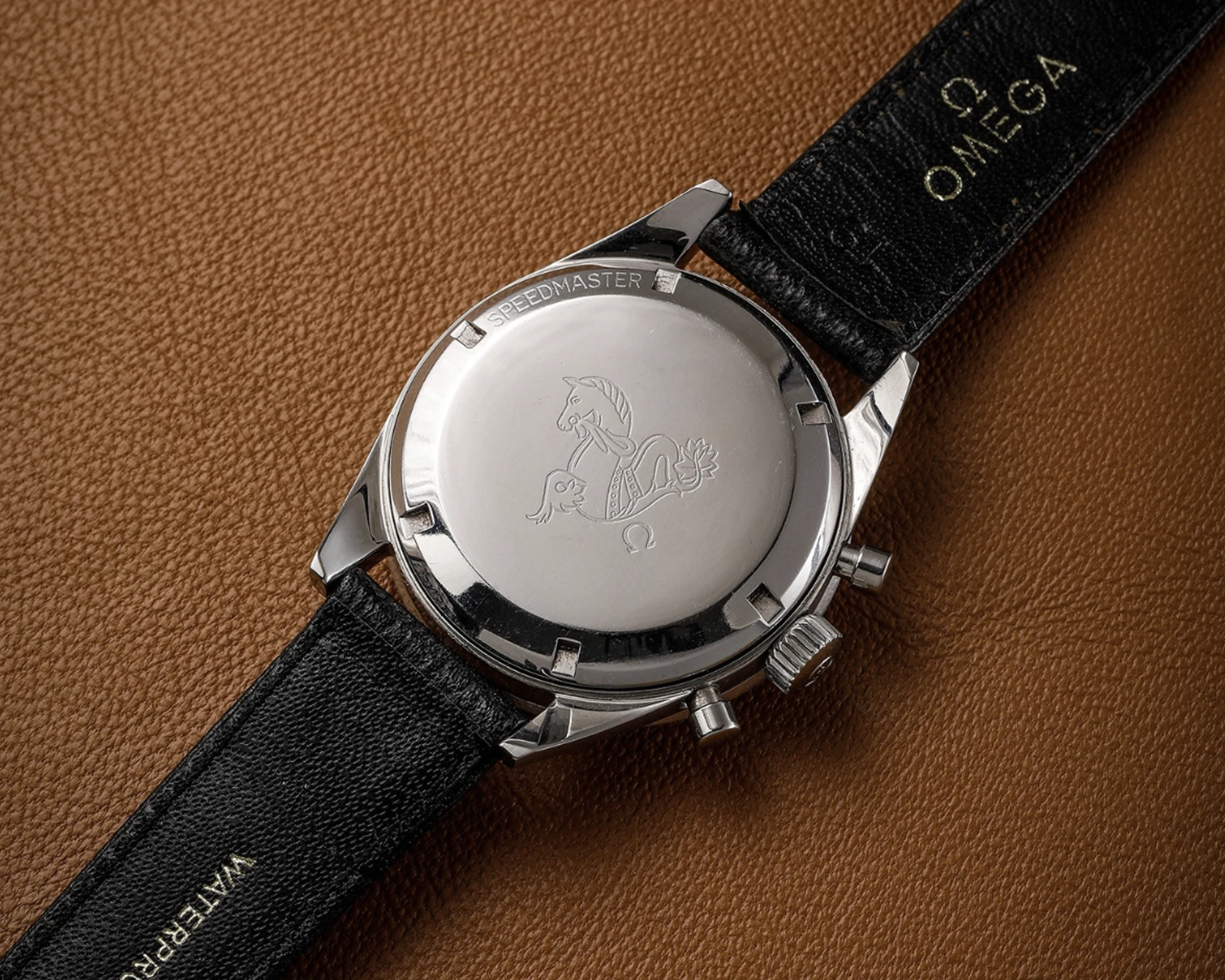
Credit © Phillips
The desirability of this timepiece became evident as bids continued to soar even after surpassing the million-dollar mark, bids from Texas, Oman, and China pushed the price higher, effortlessly breaking the two-million barrier. Finally, the hammer fell at an astounding 3,115,500 CHF, catapulting Omega into the prestigious league of Rolex and Patek Philippe. With this price, the watch made history as the most expensive Omega ever sold, shattering the previous record and far exceeding the pre-auction estimate set by Phillips at 80,000 to 120,000 CHF.
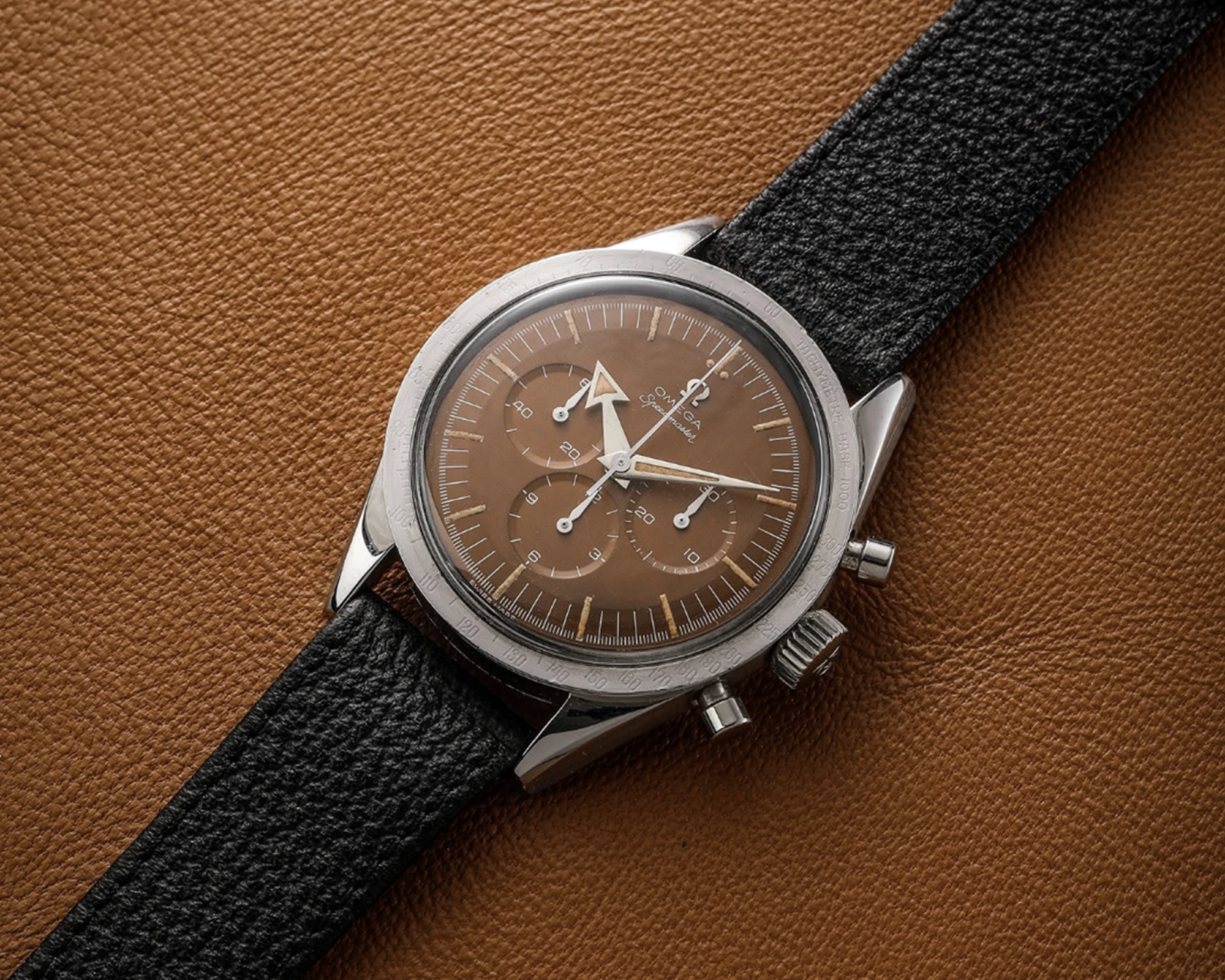
Credit © Phillips
However, what no one could have foreseen at the time: The watch was not the rare artifact it was made out to be in the auction catalogue, but a counterfeit that had been assembled by fraudsters using multiple watches and replica parts. This revelation led vintage watch specialist Sacha Davidoff to remark that it was more of a ‘Frankenstein watch’ than a true vintage piece. And the buyer? According to an investigation by the Neue Zürcher Zeitung (NZZ), it was none other than Omega itself.
This article features the most expensive Omega wristwatches to date,
as of September 2024.
| Model | Price realised |
|---|---|
| 10. Ref. CK2915-1 | approx. CHF 260,034 (HKD 2,394,000) |
| 9. Ref. 145.012-68SP | approx. CHF 277,229 (USD 327,600) |
| 8. Ref. BA 345.0052.035 | CHF 312,500 |
| 7. Ref. 2915-1 | CHF 408,500 |
| 6. Chronometre à Tourbillon | CHF 512,500 |
| 5. Ref. 145.022 “Alaska Project” | CHF 529,200 |
| 4. Ref. 145.012-67 SP | approx. CHF 565,513 (USD 667,800) |
| 3. ‘Tourbillon 30 I’ | CHF 1,428,500 |
| 2. Ref. H6582/D96043 | CHF 1,812,500 |
| 1. Ref. 2915-1 | CHF 3,115,500 |
